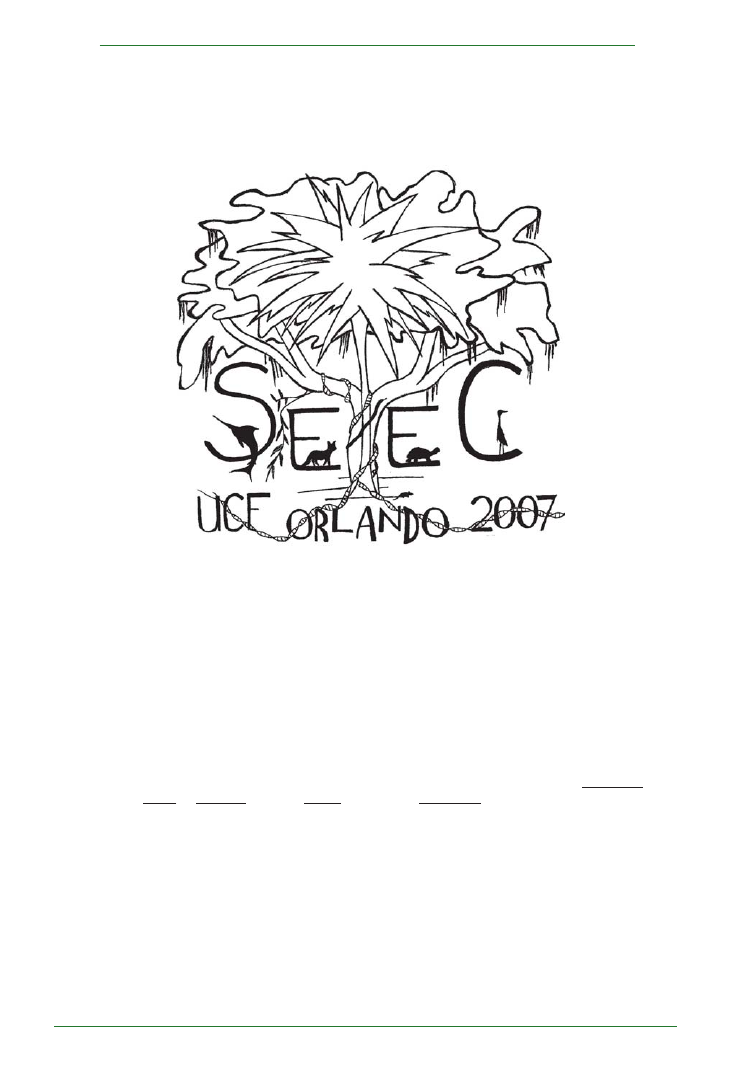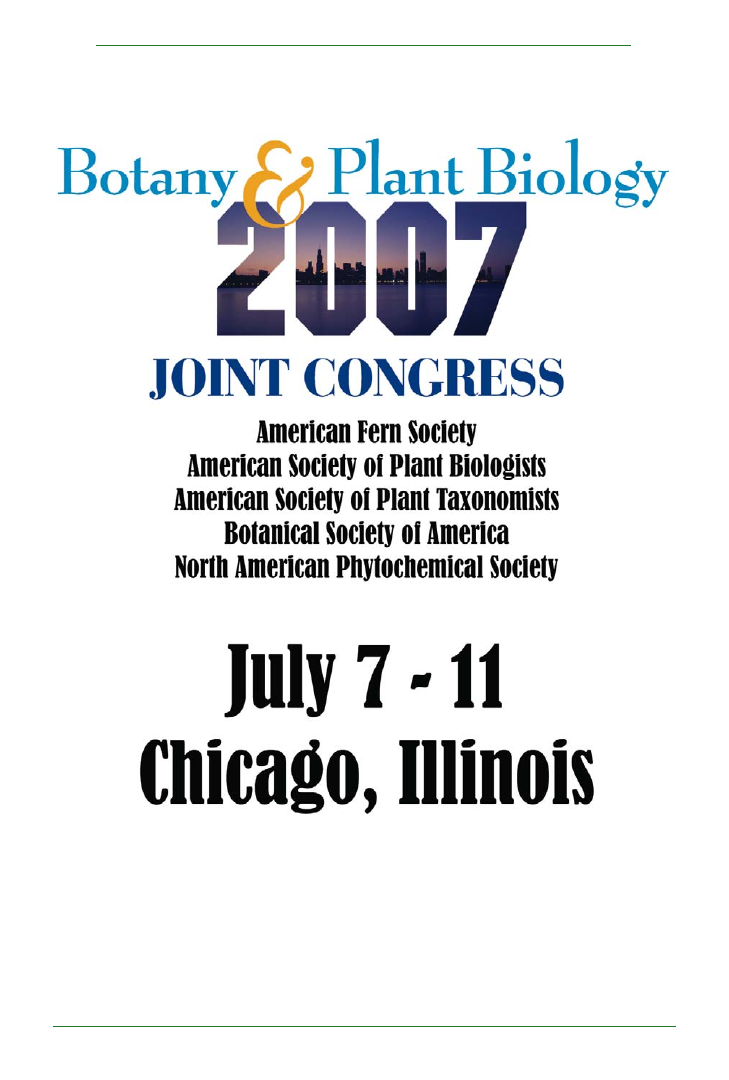
BULLETIN
SPRING 2007
VOLUME 53
NUMBER 1
PLANT SCIENCE
ISSN 0032-0919
Editor: Marshall D. Sundberg
Department of Biological Sciences
Emporia State University
1200 Commercial Street, Emporia, KS 66801-5707
Telephone: 620-341-5605 Fax: 620-341-5607
Email: psb@botany.org
The Botanical Society of America: The Society for ALL Plant Biologists
Welcome to Our Second Century!.....................................................................2
Public Gardens and the New Family Visitor.................................................2
Allelopathy or Pseudo-allelopathy in Classroom Experiments?.........................6
News from the Society
2007 Darbaker Prize in Phycology.............................................................12
BSA Science Education News and Notes..................................................12
Editor’s Choice. Botany in Science Education Journals..............................14
Announcements
In Memoriam:
Jack Myers, 1913–2006............................................................................15
Kingsley R. Stern, 1927-2006.....................................................................17
Personalia
Dr. Meredith Blackwell..............................................................................18
Dr. James S. Miller..................................................................................18
Symposia, Conferences, Meetings
Southeastern Ecology and Evolution Conference........................................19
The Twelfth Symposium on the Natural History of the Bahamas.................20
Positions Available
Curator, William L. Brown Center for Plant Genetic Resources,
St. Louis, Missouri ...........................................................................20
Award Opportunities
Grants for Ornamental Horticulture...........................................................21
Other
Protected Areas in Madagascar: Biodiversity, Development.........................21
Missouri Botanical Garden‘s Recycling Program Saves 70,000 Pounds
of Horticultural Plastic from Landfills..................................................22
Books Reviewed
........................................................................................23
Books Received
.......................................................................................35
BSA Contact Information
.........................................................................36
Botany 2007.............................................................................................36

2
Plant Science Bulletin 53(1) 2007
P
LANT
S
CIENCE
B
ULLETIN
POSTMASTER: Send address changes to:
Botanical Society of America
Business Office
P.O. Box 299
St. Louis, MO 63166-0299
E-mail: bsa-manager@botany.org
Address Editorial Matters (only) to:
Marsh Sundberg, Editor
Dept. Biol. Sci., Emporia State Univ.
1200 Commercial St.
Emporia, KS 66801-5057
Phone 620-341-5605
E-mail: psb@botany.org
ISSN 0032-0919
Published quarterly by Botanical Society of America, Inc., 4475 Castleman Avenue, St. Louis,
MO 63166-0299. The yearly subscription rate of $15 is included in the membership dues of
the Botanical Society of America, Inc. Periodical postage paid at St. Louis,MO and additional
mailing office.
Welcome to Our Second Century!
What could be better than celebrating the 100
th
anniversary of the Botanical Society of America?
Why, starting off in our second century of course! And
what a way to begin. This year, for the first time in
three decades we will be meeting jointly with one of
our offspring societies, the American Society of
Plant Biologists (the last time we met together they
were the American Society of Plant Physiologists).
This will be the largest gathering of botanical
scientists in North America since the 16
th
International
Botanical Congress in St. Louis in 1999 and it
promises to be the most exciting.
Chicago is our host city and there are plenty of
botanical attractions to take advantage of before,
during, or after the meetings. One of these is the
Morton Arboretum in Lisle, Illinois, half and hour
west of the city. In our lead article, Katherine Johnson
introduces some of the programs introduced at the
Arboretum to attract more of the general public and
educate them about the importance of plants.
Of course most of the excitement will center on the
meetings themselves and for botanical educators
there will be a wealth of workshops and presentations
from many of the leading science educators in
biology. Many of us realize that one of the greatest
problems we face in the classroom is having to
overcome some deeply ingrained alternative
conceptions (misconceptions) students bring with
them to our classrooms. In our second article David
Hershey elaborates on some of the misconceptions
involving allelopathy that have found their way into
textbooks and laboratory manuals. In doing so he
provides he provides lots of ideas for authentic
inquiry that can be done in the classroom.
I hope these articles will whet your appetite for the
meetings this summer. Register now and I’ll look
forward to seeing you there.
-Editor
Public Gardens and the New
Family Visitor
Public Gardens and arboreta have an important
mission – and a huge challenge – facing them.
Teaching the “general public” about the importance
of trees and other plants was never more difficult
than in today’s world with shifting demographics,
stiffer competition for leisure time activities,
declining connection with nature, and changes in
Dr. Gerard T. Donnelly
our audience’s need for safety and structured
activities.
We have always drawn an audience who
appreciates nature. These people already

3
Plant Science Bulletin 53(1) 2007
Editorial Committee for Volume 52
Joanne M. Sharpe (2009)
Coastal Maine Botanical Gardens
P.O. Box 234
Boothbay ME 04537
joannesharpe@email.com
Nina L. Baghai-Riding (2010)
Division of Biological and Physical Sciences
Delta State University
Cleveland, MS 38677
nbaghai@deltastate.edu
P
LANT
S
CIENCE
B
ULLETIN
Andrea D. Wolfe
(2007)
Department of EEOB
1735 Neil Ave., OSU
Columbus, OH 43210-1293
wolfe.205@osu.edu
Samuel Hammer (2008)
College of General Studies
Boston University
Boston, MA 02215
cladonia@bu.edu
understand the value of plants. They visit our
institutions for many reasons: to find respite
around the greenery, to admire the gardens, to
watch birds, or to hike along native landscapes.
Unfortunately, these visitors represent only a
fraction of our potential audience. For our
institutions to fulfill our missions, we need to
attract the growing number of families who, unlike
traditional public garden visitors, do not feel drawn
to nature and our institutions.
Young families today have had fewer opportunities
for quality outdoor experiences, and they are less
familiar with nature than their parents and
grandparents. They often have structured lives
with scheduled play dates, soccer practice, and
programmed activities of every sort. Parents may
not be prepared to lead their children on an
adventure around a public garden because they
lack an understanding of nature, having not played
outside much as children themselves. To attract
these families, we must appeal to their preference
for structured activities and their need for more
interpretation of what they encounter. We must
introduce them to the wonders of nature and sustain
their interest on a long-term basis.
New Facilities to Attract New Families
Ten years ago, the leadership of The Morton
Arboretum, under the direction of Dr. Gerard T.
Donnelly, President, began addressing how to
attract families to the Arboretum by initiating major
improvements to the site. Plans included building
a larger visitor center, an ecologically friendly parking
lot, an intriguing one-acre Maze Garden, and a four-
acre state-of-the art Children’s Garden.
Children’s Garden
Jenny Archibald
Department of Ecology and Evolutionary Biology
The University of Kansas
Lawrence, Kansas 66045
jkarch@ku.edu

4
Plant Science Bulletin 53(1) 2007
The transformation of the site took several years.
Meanwhile, staff worked to produce programming
geared to this audience, experimenting with family
concerts, temporary exhibitions such as tree
houses, winter recreational activities, and other
events in order to spark new interest and bring in
new visitors. These special programs succeeded
in boosting attendance figures on specific days but
did not lead to a daily increase in numbers. That
took building the permanent Children’s Garden to
accomplish.
Appealing to Family Needs
In the five years before opening the Children’s
Garden, some questioned if we were turning The
Morton Arboretum into a Disney-like amusement
park by building a garden with colorful exhibits and
playground equipment. Some people argued that
this type of garden deprives children, as well as
adults, of “real” natural experiences. They
expressed concern that we might plan to build
similar exhibit gardens all over the Arboretum
grounds.
Fears were put to rest when the garden opened to
members on Labor Day weekend 2005 and then
to the general public a week later. Skeptics could
see that the manufactured garden elements did
not eclipse the rich diversity of plants, but did
indeed enhance a child’s garden experience, as
intended. Families praised the garden and
membership soared. Because the Children’s
Garden sits on only four of The Morton Arboretum’s
1,700 acres, plenty of natural areas remain for
those seeking solitude.
More importantly, many parents have told us that
they never would have considered visiting The
Morton Arboretum before the Children’s Garden
was built because “there was nothing to do” on our
site. Clearly we needed this garden to attract and
grow our audience!
Part of our Children Garden’s success stems from
parents’ needs for a safe, interactive place to bring
children. When surveyed, a majority of parents rate
“safety” as a main concern in any experience
designed for children. Fears of serious injury or
abduction compel parents to watch their children
closely and favor structured activities over
unsupervised play. Parents must enjoy the
experience of bringing their children and be able to
relax themselves, or it will not be worth the effort.
Moreover, if parents perceive a woodland trail as
boring, so will their children. If parents’ unfamiliarity
with the surroundings makes them feel
uncomfortable, they will pass along their fears and
never bring the family. Attracting today’s families
may require taking a few lessons from Disney by
building family-centered garden spaces where
structured activities and botanical display receive
equal emphasis.
Testing and Measuring Success
In the summer months before the Children’s Garden
opened to the public, we hired a team of professional
exhibit evaluators to conduct a formative study of the
garden. We wanted to gain insight into how families
would move through the space, what areas held the
most and least interest, and what things we might
need to change in order to ensure a safe and
attractive garden.
The study revealed that by offering a variety of things
to do, the Children’s Garden succeeded in engaging
a wide age range of children. Toddlers delight in
playing with musical flowers and sliding down a
giant tree root while older children gravitate to
climbing structures. Wide age appeal is especially
beneficial to families with multiple children because
the garden provides something for everyone to do.
Especially important were the study’s findings that
families understood our messages about plants
and nature. The study also assured us that this
environment would serve families well.
Because of this pre-opening trial, we knew that
families would love the garden. We knew that
Children’s Garden

5
Plant Science Bulletin 53(1) 2007
children quickly developed a sense of ownership of
the garden, which allowed parents to let their children
take more of the lead in deciding where to go. This
freedom to explore is exactly what young children
need to develop a personal connection to nature. It
is what will encourage them to return and foster a
profound appreciation for nature.
The physical and programmatic enhancements to
The Morton Arboretum, especially the Children’s
Garden, along with new marketing strategies, have
indeed attracted new families to our site. Attendance
figures over the first 12 months since the Children’s
Garden opened exceeded the previous year’s
numbers by 55-percent. An overwhelming number
of visitors immediately decided to become
members because they planned to return many
times. Our membership total at the end of August
2006, one year after the Children’s Garden opened,
was 50 percent higher than the year before.
Challenges of a Changing Audience
However valuable that pre-opening evaluation
proved, no visitor study could have helped us
anticipate some of the challenges we faced after the
Children’s Garden became a regular attraction
when strong visitorship became a daily occurrence
and the character of our general audience changed.
We are learning to address three types of challenges:
the practical issues of serving a large “stroller”
audience, the need to introduce appropriate
behavioral guidelines to a large group of new
members, and the need to teach two generations
about the wonders of nature.
Serving a Large Stroller Crowd
The first challenge crept up on us. At lunchtime on
a fair weather day, our new, expanded cafeteria was
burgeoning with young families. The noise level
disturbed patrons who had come to enjoy a quiet
lunch with friends. As a result, some visitors were
discouraged from dining in our restaurant. Patrons
crammed strollers into restrooms, which required
more frequent servicing.
Building spaces filled and so did programs. Waiting
lists for some children’s classes were twice as long
as the enrollment limit. As can be expected with any
supply and demand imbalance, customers
complained about not being able to get into
programs and threatened to drop their
memberships.
Meeting the challenge of increasing attendance
has required ramped-up services and new ideas
such as satellite cafeteria stations to relieve the
crowds inside. We also embraced customer service
training so that all front line staff would be equipped
to handle complaints with poise.
Introducing Behavioral Guidelines
Our second challenge has been to accept that we
are attracting a greater number of people who do not
understand how an arboretum differs from a park.
Families arrive in bathing suits to play in our stepping
stone pond as if it were a water park. They bring
footballs to toss around. We have always needed to
explain why people cannot climb trees on our site,
but now there are more people who need to be told
why we cannot allow them to hang on our tree
collections, run through plant beds, and pick the
foliage.
While frustrating to horticulturists and program staff
alike, this challenge has proved a little easier to
master. Parents genuinely want to know what they
may and may not do and abide by the rules. Initially,
we resisted posting rules and signs announcing
restrictions but now recognize that parents find
these guidelines comforting because they remove
ambiguity and make expectations universal.
Teaching Two Generations About Nature
Our third challenge is related to the second and
should be viewed more as an opportunity than a
problem. Just as some families do not know how
to behave appropriately at a public garden, an
alarming number of them display a lack of general
knowledge of plants and animals. Nearly every day
in August, visitors asked where the tadpoles from
our pond had gone. They were disappointed not to
find them because there had been so many in
spring. Families were astonished that there was a
connection between the huge pink lotus blossom
and those conical brown things with the holes (the
seed pods). When a turtle took up residence in the
pond, it was frequently misidentified as a frog.
The simple solution to this third challenge is more
interpretation, especially by trained guides who
interact with visitors and help correct
misconceptions. We have armed our volunteer staff
with “pocket topics” that they carry around the garden
Macguvers (
Morton Arboretum Children’s Garden Youth
Volunteers
)

6
Plant Science Bulletin 53(1) 2007
to teach visitors basic facts about the plants, insects,
and wildlife that inhabit the garden. The opportunity
to share new information with visitors this way has
energized many of our volunteers. Now they play an
essential role in fulfilling our mission: sparking
interest and curiosity in nature for a new audience.
We are also running a training program for teens
called “Macgyvers” – which stands for Morton
Arboretum Children’s Garden Youth Volunteers.
These teens lead educational activities for children
aged 3 – 7. The little children learn more about
nature, while the highly-trained Macgyvers gain
presentational and other skills.
No matter how dynamic and exciting our Children’s
Garden may be, we know that it will not hold a
person’s attention forever. Eventually, novelty will
wear off and many families will pursue the next
exciting thing at the nearby zoo or children’s museum.
We anticipate some attrition with our membership
and are planning ways to hold on to as many of the
new members as possible.
We always intended to use the Children’s Garden
as a springboard to the rest of the Arboretum, but we
have found that most families never venture beyond
the central area that includes the Children’s Garden,
Visitor Center, and Maze Garden. We’ve seen plenty
of parents dragging children out of these gardens,
kicking and screaming because they don’t want to
leave, attempting to console them with promises
that they’ll return another day. Getting families who
are attached to the new attractions to explore other
parts of the Arboretum will take some effort and
creative programming.
Over the first summer of operation, we offered
families a booklet that suggested six other places
to visit at the Arboretum. To pique their interest, each
destination was linked to one of the areas of the
Children’s Garden. The brochures proved popular,
and parents expressed appreciation for the
additional opportunities for things to do with their
families. A simple follow-up survey revealed that the
great majority families had not visited any of the six
areas, but that most planned to do so some time in
the future. We plan to explore a variation of this idea
next year.
Conclusion
Our society is changing in terms of its connection to
nature. We have a population of young people,
children and adults, who have learned more about
plant life cycles and monarch migration from
watching the Discovery channel than from playing
outdoors. Our challenge is to draw them away from
electronic entertainment long enough to capture
their interest in the action off screen. If we succeed
in showing them first hand what they have learned
at a desk at school or on television, then we can go
a long way to fostering appreciation for the natural
world and our public gardens as institutions that
preserve nature.
Katherine Johnson is Children’s Garden Manager
at The Morton Arboretum in Lisle, Illinois, and can
be contacted at
kjohnson@mortonarb.org
Allelopathy or Pseudo-allelopathy
in Classroom Experiments?
There are numerous plant misconceptions in the
biology teaching literature (Hershey 2004-2005).
Allelopathy is one popular lab activity particularly
fraught with misconceptions. Allelopathy is defined
as a plant naturally releasing an organic chemical,
termed an allelochemical, that inhibits or promotes
growth of another plant growing nearby. Allelopathy
was included in many textbooks as an important
factor in plant ecology largely because of claims in
a Science cover article. Muller et al. (1964) observed
grass-free zones around three native California
shrubs, (Salvia leucophylla, S. apiana, and
Artemisia californica), and claimed that the bare
zones were caused by allelopathy. This conclusion
was supported by lab experiments that showed that
volatile terpenes from the shrubs inhibited cucumber
and oat seedling root growth in the lab.
Muller’s photo of bare zones around the shrubs was
published in many biology and botany textbooks as
a classic example of allelopathy. Muller (1953) went
from being a strong critic of allelopathy claims to
being a leading allelopathy supporter (Muller et al.
1964, Muller 1966). Yet, some of Muller’s (1953)
criticisms of allelopathy research applied to his
later allelopathy experiments, e.g. “The production
of toxic material capable of killing seedlings of
other species under experimental conditions
does not in fact relieve the shrub of competition
and thus constitute an advantage of survival value.
The failure of this toxic principle to be effective in
the natural habitat is possibly attributable to the
activity of the microflora in breaking down the
toxin or to its adsorption by colloidal components
of the desert loams.” Bartholomew (1970) seriously
undermined Muller’s allelopathy hypothesis when
he found that fencing sections of the bare zone
allowed grass to grow there. Bartholomew’s
conclusion was that the bare zone was caused by
rodents, rabbits and birds using the shrubs as
protection from predators while feeding on nearby
grass seedlings.
Halsey (2004) provided a valuable historical analysis
of Muller’s allelopathy research and Muller’s
vigorous defense against its critics. As is often the

7
Plant Science Bulletin 53(1) 2007
.
case, once a misconception gets into the teaching
literature, it is difficult to eliminate (Hershey, 2004b).
Allelopathy usually is presented as established fact
in biology textbooks but its existence and importance
in nature remain uncertain. Halsey (2004)
concluded that “Allelopathy remains a
controversial topic today despite hundreds of
investigations because of the difficulty in isolating
all the possible variables affecting plant growth.”
Even leading allelopathy researchers admit that
allelopathy has a bad reputation because of artificial
experiments and unwarranted extrapolations
(Mallik, 2005).
“Allelopathy” Teaching Experiments
There have been several allelopathy teaching labs
recommended in the last twenty years. Yet, all have
some of the same major flaws as older allelopathy
research articles. In addition, they often mislead
students into thinking that allelopathy is an
uncontroversial subject and is easy to demonstrate
with artificial lab experiments. Claims of allelopathy
are often controversial because it may be
impossible to separate allelopathic effects from
other effects on plant growth (Inderjit and del Moral,
1997).
Hibbs and Shumaker (1987) recommended
classroom experiments on intraspecific allelopathy
of devil’s backbone (Kalanchoe daigremonatiana).
In one experiment, a large plant was planted in a flat
of perlite or potting soil, and adventitious plantlets
from that plant were placed in a grid pattern on the
medium surface. A photo showed that the plantlets
beneath the large plant remained small while those
beyond the canopy of the large plant grew much
bigger. However, the large plant shaded the plantlets
beneath it and competed with nearby plantlets for
mineral nutrients and water. The large plant may
also have altered the rootzone pH to the detriment
of the plantlets. No measurements were made to
determine if an allelochemical was naturally being
released from the large plant.
Hibbs and Shumaker (1987) also grew adventitious
plantlets in flats of perlite with and without an
aqueous extract of 200 g macerated K.
daigremonatiana tissue per liter. Plantlet growth
was inhibited but that technique was extremely
artificial. In nature, plants do not macerate
themselves as part of an allelopathic defense.
Inderjit and Nilsen (2003) emphasized that grinding
plant tissues to extract allelochemicals, or “grind
and find,” must be avoided in allelopathy research.
A realistic treatment might have been to apply
rainwater to shoots of an intact plant, catch the runoff
and irrigate plantlets with the runoff to determine if
allelochemicals leach from shoots. Perlite is an
unrealistic medium for allelopathic experiments
because it is chemically and biologically inert
compared to soil (Bunt 1988). Soil or soil microbes
may inactivate allelochemicals (Muller 1953).
Marcus and Burz (1994) claimed that radish
seedlings were allelopathic to lettuce seedlings in
classroom experiments yet their results could not
be confirmed (Santaniello and Koning, 1996). A
photo in Marcus and Burz (1994) had the caption
“Lettuce seeds when placed in Petri dishes with
radish seeds failed to germinate.” Yet the photo
showed several lettuce seedlings in the Petri dish!
(Hershey 1994a) No data were presented, just the
photos. Even if radish partly inhibited lettuce
germination or growth, it would not necessarily be
due to allelopathy. It could be due to plant competition
for light, water and mineral nutrients. Marcus and
Burz (1994) cited Choesin and Boerner (1991) to
support their claim that allelochemicals from some
Brassicaceae inhibit seed germination. However,
Choesin and Boerner (1991) concluded that “Under
our experimental conditions, Brassica napus
showed no indication of being allelopathic ...”
Latto and Wright (1995) found an inhibition of seed
germination that might have been due to allelopathy
in just one of nine treatments. Their technique of
collecting supposed allelochemicals from seeds
germinated on filter paper and then reusing the filter
paper to germinate other seeds was problematic.
Changes in the chemical, physical or biological
properties of the filter paper itself may have affected
germination of a second batch of seeds (Hershey,
1996).
Frame (1998) also germinated seeds in Petri dishes.
The test seeds were treated with leachate from
alfalfa sprouts. Fives grams of alfalfa sprouts were
submerged in 25 ml of distilled water for 48 hours.
That was artificial because under natural conditions
any leachate is from rain or overhead irrigation on
intact plants. Submerging alfalfa seedlings for 48
hours might be long enough for them to start to
decay and for substantial microbial growth to occur.
Frame (1998) might have inadvertently been testing
the effects of a microbe or microbial toxin on seed
germination.
Teaching experiments on allelopathy often
germinate seeds in a Petri dish on filter paper
wetted with tap or distilled water. That is not the best
technique because a Petri dish is a very stressful
and artificial environment. Seeds and seedlings
will be deficient in most mineral nutrients and
possibly rootzone oxygen if the filter paper is
overwetted. Seeds or seedlings may also be subject
to periodic drought as there are minimal moisture
reserves in the filter paper, and most of the water
may evaporate from the filter paper and condense
on the Petri dish lid. Seeds germinated on filter

8
Plant Science Bulletin 53(1) 2007
paper with distilled water may experience drastic
changes in rootzone pH due to lack of buffering.
Use of distilled water for seed germination should
be avoided. The harmful effects of distilled water on
plants has long been recognized (True, 1914;
Hibbard, 1915). Calcium and boron are of special
concern because both are required external to the
root for normal root functioning (Bohnsack, 1991;
Lauchli and Epstein, 1970). Roots without calcium
in the bathing solution have “leaky” cell membranes.
Such “leaky” roots may cause artifacts in allelopathy
experiments by allowing entry of chemicals that
normal roots might exclude.
Garlic “Allelopathy” Experiments
Shimabukuro and Haberman (2006)
recommended allelopathy experiments with garlic
(Allium sativum ) but did not cite any literature that
claimed garlic was possibly allelopathic. They used
the same basic lab technique as Muller et al. (1964)
by examining inhibitory effects of a volatile chemical
on seed germination and seedling root growth.
Even Muller (1982) later referred to his 1964
technique as “contrived.” The “contrived” technique
in Shimabukuro and Haberman (2006) produced
a nearly complete inhibition of lettuce seed
germination supposedly due to volatile chemicals
from crushed garlic in sealed Petri dishes. However,
the experiment was extremely artificial because the
seeds were in a sealed Petri dish, the garlic was
crushed, and there was no soil, just filter paper and
distilled water. Under natural conditions, any garlic
volatiles
1. would have come from uncrushed garlic plants
so would have differed in chemical composition,
e.g. the volatile chemical, allicin, is formed
enzymatically when garlic is crushed,
2. would have been present at a lower concentration,
3. would not have been concentrated around the
seeds in a sealed Petri dish but could have diffused
away,
4. might have been inactivated by adsorption to soil
particles or by the action of soil microbes.
The garlic experiments failed to avoid some of the
problems mentioned by Shimabukuro and
Haberman (2006) in their introduction, i.e. “Often
unrealistically high doses of the active chemicals
are used and the experiments are conducted in
the absence of soil.” A more realistic experiment
would have been to place an uncrushed garlic clove
in a pot of potting soil used to germinate lettuce
seeds. Detrimental effects of chemicals released
by artificially crushing plant parts on the growth of
other plants is not true allelopathy. Allelopathy
involves a plant naturally releasing allelochemicals.
Inderjit and Nilsen (2003) recommended against
lettuce as a test species in allelopathy experiments
because it is an “artificially sensitive species.”
“The Dose Makes the Poison”
In an attempt to determine if garlic was allelopathic
under field conditions, Shimabukuro and Haberman
(2006) also grew lettuce seedlings in a pot containing
10 g crushed garlic and 18 g of dry potting soil.
However, that was an unrealistically high dose as
the following calculations indicate. Organic potting
soils usually have a bulk density of about 0.1 g/ml
(Bunt 1988) so the bulk volume of the potting soil
was about 180 ml or 0.00018 cubic meter. Ten
grams or 0.01 kg of crushed garlic per 0.00018
cubic meter equals 56 kg/cubic meter.
The volume of a hectare furrow slice is 15 cm (0.15
m) times 10,000 square meters or 1500 cubic
meters. Thus, there would be 1500 times 56 kg or
84,000 kg crushed garlic per hectare. A high average
garlic yield was reported to be 11,200 kg/hectare
(Rosen et al. 1999). The application rate for the
teaching experiment was the equivalent of plowing
under 7.5 crops of garlic bulbs at once. That is
unrealistic. Plowing under a single crop would be
equivalent to about 1.3 g crushed garlic per 18 g of
dry potting soil. Even that would be unrealistic
because the point of growing garlic is to harvest the
bulbs for sale, not plow them under.
Some gardeners do spray plants with crushed
garlic in water to repel insects and prevent diseases.
Thus, a relevant classroom experiment could
examine if a garlic spray might inadvertently inhibit
the growth of plants it was meant to protect. Such a
realistic and relevant experiment may not produce
the dramatic results of the artificial experiments in
Shimabukuro and Haberman (2006) but it is much
preferable.
Competition for Resources or Allelopathy?
A major problem with allelopathy research is that it
is very difficult, if not impossible, to separate effects
of plants competing for resources from allelopathic
effects (Inderjit and del Moral, 1997). Classroom
allelopathy experiments should address this
problem so that students do not get the
misimpression that allelopathy is easy to recognize
in real situations.
Simple and unequivocal classroom demonstrations
of allelopathy with intact plants may one day be
possible by genetically engineering suspected
allelopathic plants so they do not produce an
allelochemical. One experimental treatment would
then involve growing the normally allelopathic
species A in the same pot with species B. The
control treatment would involve growing species A,

9
Plant Science Bulletin 53(1) 2007
engineered so it could not produce the
allelochemical, in the same pot with species B. The
effects of species A competing with species B for
resources (water, mineral nutrients, light, etc.) could
then be separated from allelopathic effects. Such
an approach has already been applied to tobacco
to demonstrate that nicotine functions to protect the
plant from insects (Steppuhn et al., 2004). A tobacco
engineered so it produced very little nicotine suffered
about three times more leaf area loss to insects
than tobacco producing normal nicotine levels.
Pseudo-allelopathy
Many of the research and classroom experiments
that claimed to demonstrate allelopathy did not truly
examine allelopathy because two plant species
were not grown together. Instead, there was an
artificial (human-caused) release of toxic chemicals,
often at unrealistically high doses. Harper (1994)
stated “Almost all species can, by appropriate
digestion, extraction and concentration, be
persuaded to yield a product that is toxic to one
species or another.” The teaching experiments
discussed above add support for Harper’s claim
because most did not use a species considered
allelopathic under natural conditions.
Situations where people artificially cause release
of toxic chemicals from one plant that damage
another plant should not be considered allelopathy.
To differentiate between them, the term pseudo-
allelopathy could be used for situations where an
artificial release of chemicals from one plant harms
or benefits another plant. Pseudo-allelopathy occurs
in agriculture and horticulture. Some types of fresh,
ground tree bark used as mulch or in potting media
are toxic to seedlings (Bunt 1988).
Plants often produce secondary compounds that
function in defense against animals or microbes.
High doses of these chemicals may also be
detrimental to plants in pseudo-allelopathy
experiments but that does not necessarily mean
they act as allelochemicals under natural conditions.
For example, tobacco plants produce nicotine for
defense against herbivores. Nicotine is also used
as a commercial pesticide. An overdose of nicotine
pesticide can also damage the plant it was meant
to protect.
Better Classroom Experiments
Alternatives to classroom allelopathy experiments
that also deal with effects of chemicals on plant
growth involve plant mineral nutrition, a fundamental
but often underemphasized topic in biology
(Hershey 1993). Plant mineral nutrient deficiencies
and toxicities are straightforward classroom
experiments (Hershey 1994b). Unlike the
controversy of many purported allelopathic effects,
there is no controversy that plants will become
deficient when they do not get enough of an essential
mineral nutrient. Rootzone pH effects on plant growth
are also easy for students to study (Hershey 1992).
Few student labs have the equipment required to
identify or quantify an allelochemical, yet students
can easily and cheaply measure pH. The detrimental
effects of the lack of calcium and boron in solutions
bathing roots can be detected quickly. When placed
in a solution lacking boron, squash (Cucurbita
pepo) root elongation was measurably reduced in
three hours (Bohnsack and Albert 1977; Bohnsack
1991). Corn (Zea mays) seedling roots placed in a
solution lacking calcium begin to leak potassium
within 30 minutes (Lauchli and Epstein 1970).
Other relevant classroom experiments on
chemicals affecting plants are those on salinity,
plant hormones and herbicides. Molisch, who
coined the term allelopathy in 1937, considered the
plant hormone, ethylene, from apple fruit to be an
allelochemical (Mallik, 2005). Especially relevant
are experiments with herbicides created because
of purported allelochemicals. Mesotrione,
tradename Callisto, is an herbicide that controls
crabgrass in lawns and broadleaf weeds in corn
(Cornes 2005). It is an analog of leptospermone, a
purported allelochemical in lemon bottlebrush
(Callistemon citrinus).
A simple and relevant classroom pseudo-
allelopathy experiment consists of daffodil flowers
in a vase with tulip flowers. Cut daffodil flowers
release a toxic alkaloid(s) from the cut end of the
flower stalk into the vase solution. It reduced tulip
vase life from 7 to 4 days (Van Doorn 1998). The
alkaloid(s) also caused yellowing of tulip leaves
when it was placed directly on them. Daffodil plants
growing in soil are not considered allelopathic so
the alkaloid probably does not function as an
allelochemical under natural conditions. The fact
that cut daffodils release a toxic alkaloid(s) that
harms neighboring cut flowers but daffodil plants
do not release enough alkaloid(s) to harm
neighboring plants provides an excellent illustration
of the danger of extrapolating lab experiments to the
field.
If classroom allelopathy experiments are conducted,
it would be most relevant to use a species that
research has suggested might be allelopathic under
natural conditions, such as black walnut (Juglans
nigra), spotted knapweed (Centaurea maculosa)
and garlic mustard (Alliaria petiolata) (Bais et al.
2003; de Scisciolo et al. 1990; Stinson et al. 2006).
Both allelopathic and non-allelopathic factors that
can affect plant growth should be considered (Murray
and Winnett-Murray 2004). The test species should
be one that normally grows near the suspected

1 0
Plant Science Bulletin 53(1) 2007
allelopathic species. Research using readily
available cultivated plants as test species, such as
lettuce or sunflower, is often inconclusive because
different species can vary widely in their response
to the same purported allelochemical.
Rather than seed germination on filter paper in a
Petri dish, a more realistic classroom allelopathy
experiment would grow a suspected allelopathic
species and a test species together and attempt to
eliminate competition for water, mineral nutrients
and light. To eliminate competition for light, the
suspected allelopath could be planted in a hole in
the side of the pot, and the allelopath shoots
prevented from shading the test species planted in
the pot. Competition for water and mineral nutrients
could be eliminated by frequent irrigation with a
complete mineral nutrient solution. In one treatment,
activated charcoal would be added to the soil to
adsorb any allelochemicals excreted by the roots of
the allelopath (Inderjit and Callaway, 2003). There
would be four treatments total:
1. Control with test species alone in pot
2. Test species and suspected allelopath in pot
3. Control with test species alone in pot plus activated
charcoal
4. Test species and suspected allelopath in pot
plus activated charcoal
Bioassay Misuse
Another misconception promoted by allelopathy
research and teaching experiments is misuse of
the term bioassay. A bioassay was originally defined
as quantification of a specific chemical using a
living organism. It required the creation and use of
a standard curve. For one IAA (indole acetic acid)
bioassay, the standard curve was a graph of IAA
concentration versus the length of Avena coleoptiles
(Nitsch and Nitsch 1956). A plant extract was then
applied to other Avena coleoptiles, their length
measured and the standard curve used to estimate
the IAA concentration in the extract. Bioassays were
once the basis of most plant hormone research.
Plant hormone bioassays are still useful in teaching
experiments, e.g. the hypocotyl elongation bioassay
for gibberellic acid (Reiss 1994).
Shimabukuro and Haberman (2006) started with a
correct definition for bioassay but, despite their
claim, none of their garlic experiments was a
bioassay because none created a standard curve
or quantified a specific chemical. Unfortunately, the
definition of bioassay has been expanded by some
to include almost any experiment that studies the
effect of a chemical on a living organism (Inderjit
and Nilsen, 2003; Rice and Maness, 2004).
Conclusions
Classroom allelopathy experiments in teaching
journals are often poor models for student research.
They should be approached with caution or avoided
so students are not misinformed about the
significance of allelopathy, where a plant naturally
releases allelochemicals that harm or benefit
another plant. Halsey (2004) should be essential
reading before students or teachers attempt
allelopathy experiments. There are more realistic
classroom experiments on allelopathy than those
determining the effect of unnaturally high doses of
plant extracts on the germination of seeds on filter
paper in Petri dishes. Classroom allelopathy
experiments should also be based on a real
observation from natural or agricultural ecosystems
where one plant seems to be allelopathic to another.
David R. Hershey
Email:
dh321z@yahoo.com
Literature Cited
Bais, H.P., Vepachedu, R., Gilroy,S., Callaway, R.M. and
Vivano, J.M. 2003. Allelopathy and exotic plant invasion:
Frommolecules and genes to species interactions. Science
301: 1377-1380
http//www.sciencemag.org/cgi/content/
abstract/sci;301/5638/1377
Bartholomew, B. 1970. Bare zone between California
shrub andgrassland communities: The role of animals.
Science 170: 1210-1212.
http://www.sciencemag.org/
cgi/content/abstract/170/3963/1210
Bohnsack, C.W. 1991. Investigating the boron requirement
of plants. American Biology Teacher 53: 486-488.
Bohnsack, C.W. and Albert, L.S. 1977. Early effects
ofboron deficiency on indoleacetic acid oxidase levels of
squash root tips. Plant Physiology 59: 1047-1050.
t t p : / / w w w . p u b m e d c e n t r a l . g o v /
articlerender.fcgi?tool=pmcentrez&artid=542503
Bunt, A.C. 1988. Media and Mixes for Container-grown
Plants. London: Unwin Hyman.
Choesin, D.N. and Boerner, R.E.J. 1991. Allyl isothiocyanate
release and the allelopathic poential of Brassica napus
(Brassicaceae) American Journal of Botany 78: 1083-
1090.
http://links.jstor.orgsici?sici=0002-
9122(199108)78:8%3C1083:AIRATA%3E2.0.CO;2-P
Cornes, D. 2005. Callisto: a very successful maize herbicide
nspired by allelochemistry. Proceedings of the Fourth
World Congress on Allelopathy
http://www.regional.org.au/au/allelopathy/2005/2/7/
2636_cornesd.htm
de Scisciolo, B., Leopold, D.J. and Walton, D.C. 1990.
Seasonal patterns of juglone in soil beneath Juglans nigra
(black walnut) and influence of J. nigra on understory
vegetation. Journal of Chemical Ecology 16: 1111-1130.
h t t p : / / w w w . s p r i n g e r l i n k . c o m /
(yt0ph345h5gxpsj4nyd40vax)/app/home/

1 1
Plant Science Bulletin 53(1) 2007
contribution.asp?referrer=parent&backto=issue,9,32;journal,196,333;
linkingpublicationresults,1:104273,1
Frame, K. 1998. Involving your students in cutting-edge
biological research. Proceedings of the Association for
Biology Laboratory Education 19: 351-355.
http://www.zoo.utoronto.ca/able/volumes/vol-19/
mini.10.frame.pdf
Halsey, R.W. 2004. In search of allelopathy: An eco-
historical view of the investigation of chemical inhibition in
California coastal sage scrub and chamise chaparral.
Journal of the Torrey Botanical Society 131: 343-367.
http://www.findarticles.com/p/articles/mi_qa4017/
is_200410/ai_n11850358
Harper, J.L. 1994. Population Biology of Plants. New York:
Academic Press.
Hershey, D.R. 1992. Plant nutrient solution pH changes.
Journal of Biological Education 26:107-111.
Hershey, D.R. 1993. Plant mineral nutrition in precollege
education. Journal of Plant Nutrition 16: 203-218.
Hershey, D.R. 1994a. Allelopathy misconceptions.
American Biology Teacher 56: 261-262.
http://www.angelfire.com/ab6/hershey/ABTallelo.pdf
Hershey, D.R. 1994b. Solution culture hydroponics: history
and inexpensive equipment. American Biology Teacher
56:111-118.
Hershey, D.R. 1996. Allelopathy experiment pitfalls. Journal
of Biological Education 30: 13-14.
Hershey, D.R. 2004a. Avoid misconceptions when teaching
about plants. Actionbioscience.org original article. [August]
http://www.actionbioscience.org/education/hershey.html
Hershey, D.R. 2004b. The widespread misconception that
the tambalacoque or calvaria tree absolutely required the
dodo bird for its seeds to germinate. Plant Science Bulletin
50: 105-108.
http://botany.org/PlantScienceBulletin/psb-2004-
50-4.php#Dodo
Hershey, D.R. 2005a. Plant content in the National Science
Education Standards Actionbioscience.org original article.
[February].
h t t p : / / w w w . a c t i o n b i o s c i e n c e . o r g / e d u c a t i o n /
hershey2.html
Hershey, D.R. 2005b. More misconceptions to avoid when
teaching about plants. Actionbioscience.org original article.
[October]
h t t p : / / w w w . a c t i o n b i o s c i e n c e . o r g / e d u c a t i o n /
hershey3.html
Hibbard, R.P. 1915. The question of the toxicity of distilled
water. American Journal of Botany 2: 389-401.
h t t p : / / l i n k s . j s t o r . o r g / s i c i ? s i c i = 0 0 0 2 -
9122(191510)2:8%3C389:TQOTTO%3E2.0.CO;2-S
Hibbs, E.T. and Shumaker, C.A. 1987. Intraspecific
allelopathy. American Biology Teacher 49: 27-30.
Inderjit and Callaway, R.M. 2003. Experimental designs for
the study of allelopathy. Plant and Soil 256: 1-11.
h t t p : / / p l a n t e c o l o g y . d b s . u m t . e d u /
F u l l % 2 0 t e x t % 2 0 p a p e r s % 2 0 a n d % 2 0 a b s t r a c t s /
2003%20papers/PlantandSoil20031to11.pdf
Inderjit and del Moral, R. 1997. Is separating resource
competition from allelopathy realistic? Botanical Review
63: 221-230.
Inderjit and Nilsen, E.T. 2003. Bioassays and field studies
for allelopathy in terrestrial plants: Progress and problems.
Critical Reviews in Plant Science 22: 221-238.
http://www.biol.vt.edu/faculty/nilsen/Publications/
Inderjit%20and%20Nilsen%202003.pdf
Latto, J. and Wright, H. 1995. Allelopathy in seeds. Journal
of Biological Education 29: 123-128.
Lauchli, A. and Epstein, E. 1970. Transport of potassium
and rubidium in plant roots: the significance of calcium.
Plant Physiology 45: 639-641.
h t t p : / / w w w . p u b m e d c e n t r a l . n i h . g o v /
articlerender.fcgi?artid=396481
Mallik, A. 2005. Allelopathy: Advances, challenges and
opportunities. Proceedings of the Fourth World Congress
on Allelopathy
http://www.regional.org.au/au/allelopathy/2005/opening/
2572_mallik.htm
Marcus, B.A. and Burz, J. 1994. A simple demonstration
of allelopathy. American Biology Teacher 56: 180-181.
Muller, C. H. 1953. The association of desert annuals with
shrubs. American Journal of Botany 40: 53-60.
h t t p : / / l i n k s . j s t o r . o r g / s i c i ? s i c i = 0 0 0 2 -
9122(195302)40:2%3C53:TAODAW%3E2.0.CO;2-D
Muller, C.H. 1966. The role of chemical inhibition (allelopathy)
in vegetational composition. Bulletin of the Torrey Botanical
Club 93: 332-351.
h t t p : / / l i n k s . j s t o r . o r g / s i c i ? s i c i = 0 0 4 0 -
9618(196609%2F10)93%3A5%3C332%3ATROCI(%3E2.0.CO%3B2-
L
Muller, C.H. 1982. This week’s citation classic. Current
Contents 45: 20.
http://www.garfield.library.upenn.edu/classics1982/
A1982PM89700001.pdf
Muller, C.H., Muller, W.H. and Haines, B.L. 1964. Volatile
growth inhibitors produced by aromatic shrubs. Science
143: 471-473.
http://www.sciencemag.org/cgi/content/abstract/143/
3605/471
Murray, G. and Winnett-Murray, K. 2004. Effects of Eastern
hemlock (Tsuga canadensis) on the establishment of
interspecific seedlings. Teaching Issues and Experiments
in Ecology
http://tiee.ecoed.net/vol/v1/experiments/hemlock/
hemlock.html
Nitsch, J.P. and Nitsch, C. 1956. Studies on the growth of
coleoptile and first internode sections: A new, sensitive,
straight-growth test for auxin. Plant Physiology 31: 94-

1 2
Plant Science Bulletin 53(1) 2007
111.
h t t p : / / w w w . p u b m e d c e n t r a l . g o v /
articlerender.fcgi?tool=pmcentrez&artid=540740
Reiss, C. 1994. Experiments in Plant Physiology.
Englewood Cliffs, NJ: Prentice Hall.
Rice, S.A. and Maness, I.B. 2004. Brine shrimp bioassays:
A useful technique in biological investigations. American
Biology Teacher 66: 208-215.
Rosen, C. et al. 1999. Growing Garlic in Minnesota.
University of Minnesota Extension Publication WW-07317.
http://www.extension.umn.edu/distribution/cropsystems/
DC7317.html
Santaniello, C.M. and Koning, R. E. 1996. Are radishes
really allelopathic to lettuce? American Biology Teacher
58: 102-103.
http://plantphys.info/research/abt.58.102.3.html
Shimabukuro, M.A. and Haberman, V. 2006. An aromatic
adventure with allelopathy: Using garlic to study allelopathy
in the classroom. American Biology Teacher 68: 242-247.
Steppuhn, A., Gase, K., Krock, B., Halitschke, R., and
Baldwin, I.T. 2004. Nicotine’s defensive function in nature.
PLoS Biol 2(8): e217.
http://biology.plosjournals.org/perlserv/?request=get-
document&doi=10.1371/journal.pbio.0020217
Stinson, K.A., Campbell, S.A., Powell, J.R., Wolfe, B.E.,
Callaway, R.M., Thelen, G.C., Hallett, S.G., Prati, D., and
Klironomos, J.N. 2006. Invasive plant suppresses the
growth of native tree seedlings by disrupting belowground
mutualisms. PLoS Biology
http://biology.plosjournals.org/perlserv/?request=get-
document&doi=10.1371/journal.pbio.0040140
True, R.H. 1914. The harmful action of distilled water.
American Journal of Botany 1: 255-273.
h t t p : / / l i n k s . j s t o r . o r g / s i c i ? s i c i = 0 0 0 2 -
9122(191406)1:6%3C255:THAODW%3E2.0.CO;2-H
Van Doorn, W.G. 1998. Effects of daffodil flowers on the
water relations and vase life of roses and tulips. Journal
of the American Society for Horticultural Science 123:
146-149.
BSA Science Education
News and Notes
BSA Science Education News and Notes is a
quarterly update about the BSA’s education efforts
and the broader education scene. We invite you to
submit news items or ideas for future features.
Contact: Claire Hemingway, BSA Education
Director, at
chemingway@botany.org
or Marshall
Sundberg, PSB Editor, at
psb@botany.org.
PlantingScience —BSA-led student research and
science mentoring program
A hearty thank you to the BSA scientist mentors who
made 2006 a wonderful year for the students and
teachers participating in the PlantingScience
project! We would love to recognize each of you by
name, but hope you do not mind if we refer readers
to your shining faces instead:
http://
www.plantingscience.org/index.php?module=pagesetter
&tid=5&filter=sipscientist:eq:1&tpl=scientists
Spring, and the Spring PlantingScience Session,
are coming this February-March. In addition to
hosting the spring session, we will be active at
national meetings. Will you be in St. Louis for the
News from the Society
2007 Darbaker Prize in Phycology
The Botanical Society of America is accepting
nominations for the 2007 Darbaker Prize in
Phycology. This award is presented for meritorious
work in the study of microscopic algae, based on
papers published by the nominee during the last
two full calendar years (2005-2006). The award is
limited to residents of North America, and only
papers published in the English language are
considered.
Nominations for the 2007 award should include a
list of all of the nominee’s work to be considered for
the 2005-2006 period, and a statement of the
nominee’s merits addressed to the committee.
Nominations for the 2007 Darbaker Award should
be sent by April 30, 2007 to the chair of the Darbaker
Award Committee, Dr. Martha Cook, Department of
Biological Sciences, Campus Box 4120, Illinois
State University, Normal IL, 61790-4120; email
mecook1@ilstu.edu
. E-mail nominations preferred.

1 3
Plant Science Bulletin 53(1) 2007
National Science Teachers Association meetings?
If so, please join us on April 1 for a PlantingScience
workshop. Carol Stuessy will present an analysis
of student-scientist dialogs at the National
Association of Research in Science Teaching
meeting in New Orleans.
And, of course, there is much more going on behind
the scenes, particularly grant-writing and
partnership-building. In late April we are looking
forward to productive Steering Committee meeting,
including representatives of the American Society
of Plant Biologists, who have officially accepted the
BSA’s invitation to partner in this project. Please
email
chemingway@botany.org
if you have
questions/comments about the online inquiry and
mentorship program, or would like to know how to
become more involved.
BSA Collaboration with AAAS BioSciEdNet (BEN)
Digital Libraries Portal
The BSA has been a BEN collaborator since 2003,
and our involvement this year stepped up. BSA IT
Manager Rob Brandt participated in the December
Technical Committee Meeting. Gordon Uno,
representing the AIBS, and Claire Hemingway,
representing the BSA, joined the BEN Advisory
Board. Over 900 images from the BSA Online
Image Collection can be accessed through the
portal and that number will increase soon as
additional images from our collection are annotated
and harvested . With help from BSA members, Rob
is testing new BEN portal tools for contributing and
reviewing resources. If you haven’t taken advantage
of this great resource, peruse the possibilities at
http://www.biosciednet.org/portal/.
Spotlight on BSA Member Contributions to
Science Education
Hot off the press, with glowing reviews!
Rice, Stanley A. 2006. Encyclopedia of Evolution.
New York: Facts on File.
Stanley Rice, associate professor of biology at the
Department of Biological Sciences at Southeastern
Oklahoma State University in Durant, OK, has an
impressive track record of contributing to the BSA
Teaching Section, as well as the Oklahoma Academy
of Sciences, the National Association of Biology
Teachers, and Project Kaleidoscope. His recently
published (nearly 500 page) compendium covers
current understandings, historical developments,
biographical sketches, major misconceptions, and
thought-provoking essays. Consider this review:
“Rice’s masterful, unique work serves student,
educator, and citizen alike.”—Lynn Margulis, Ph.D.,
Distinguished University Professor, University of
Massachusetts-Amherst
(note: this book is listed in the books received for
review in this issue of PSB.)
Science Education in the National News
Enrollment increases projected to continue—Have
you noticed your classes filling to overflowing? Over
the last 14 years, enrollment in elementary and
secondary schools increased by 18%, enrollment
in colleges and universities increased by a
whopping 25%. By 2015, enrollment is projected to
increase another 6% for precolleges and 15% for
colleges.
Hussar. W.J. and Bailey, T.M. 2006. Projections of
Education Statistics to 2015 (NCES 2006-084).
U.S. Department of Education, National Center for
Education Statistics. Washington, DC: U.S.
Government Printing Office.
h t t p : / / n c e s . e d . g o v / p u b s e a r c h /
pubsinfo.asp?pubid=2006084
Stating the case for reform across education levels—
Several recent reports, all available online, cover
the gamut from city public school performance
indicators to international college completion
rankings. The findings are mixed, with
improvements in some areas and much work yet to
do in many others. A few highlights are noted below.
Although the US ranks 4
th
in the world in number of
students enrolled in college, the rank drops to 17
th
for students completing college degrees. This
international perspective sets the stage for National
Report Card on Higher Education prepared by the
National Center for Public Policy and Higher
Education. State-by-state summaries are available
on measures of preparation, participation,
affordability, completion, benefits, and learning.
Measuring Up 2006, The National Report Card on
Higher Education
http://measuringup.highereducation.org/about/
Students living in 10 major cities demonstrate
poorer understanding of science compared to the
national average. The percentage of 4
th
graders in
urban districts demonstrating a basic
understanding ranged from 35-60% versus 66%
nationally, and that of 8
th
graders was lower yet (22-
52% versus 57% nationally). Test questions
included understanding of both content and process
of science. Of great concern are indications that
students lack of the skills and reasoning needed to
learn science, and could not read simple charts or
follow elementary experiments. The National
Assessment of Education Progress (NEAP)
conducted this study on urban public school
districts in 2005 as part of the Nation’s Report Card
on academic achievement of elementary and
secondary students in the US.
The Nation’s Report Card, Science Report for the
Trial Urban District Assessment

1 4
Plant Science Bulletin 53(1) 2007
http://nationsreportcard.gov/tuda_science/
According to the Education Week’s annual report,
which tracks state K-12 performance and policies
regarding student readiness, states appear to be
tackling college-preparedness. Although only 11
states have formal definitions of college readiness,
26 have joined the American Diploma Project
network, which seeks to better align high school
graduation requirements with college readiness
standards.
Quality Counts 2007 From Cradle to Career:
Connecting American Education from Birth to
Adulthood
http://www.edweek.org/ew/articles/2007/01/04/
17execsum.h26.html
Editor’s Choice. Botany in Science
Education Journals
Boyd, Amy. Plants and Perpetrators: Forensic
Investigation in the Biology Classroom. American
Biology Teacher Online
http://www.nabt/sites/S1/
File/pdf/068-09-0025.pdf
Students become sleuths
as they apply their knowledge of plant anatomy and
morphology to solve a murder mystery.
Zheng, Zhi-Liang. Use of the g11 Mutant and the CA-
rop2 Transgenic Plants of Arabidopsis thaliana in
the Biology Laboratory Course. American Biology
Teacher Online
http://www.nabt/sites/S1/File/pdf/
068-09-0026.pdf
Provide students with a real
research environment while teaching genetics
laboratory techniques and analytical skills.
Kevan, Peter G., Franco DiGiovanni, Rong H. Ho,
Hiasatomo Taki, Kriastyn A Ferguson, and Agata
K. Pawlowski. 2006. A Simple Method for Collecting
Airborne Pollen. Journal of Biological Education
40(4):181-183. What perfect timing to have the
instructions for constructing and using a simple
“megastigma” for trapping airborne pollen now that
many anemophilous trees, with their inconspicuous
flowers, are coming into bloom. Though not hi-tech
(spring clothes pins, plastic plant labels and clear
sticky tape) the authors describe some quantitative
results that students can obtain to monitor pollen
rain.
Newell, Sandra, J. Does Herbicide Resistance
Have a Cost in Brassica rapa? American Biology
Teacher 68(9):530-535. Bring the ecology of
transgenic plants into the classroom with an inquiry
into the competitive abilities of herbicide-resistant
and susceptible strains of Brassica rapa.
Ross, Paulinen, Diedre Tronson and Raymond J.
Ritchie. 2006. Modelling Photosynthesis to
Increase Conceptual Understanding. Journal of
Biological Education 40(2):84-88. Photosynthesis
has long been recognized as one of the most
conceptually difficult subjects to teach in introductory
courses with many deeply engrained
misconceptions. The methodology of this paper
supplements the traditional lecture with physical
model building, a diagramming assignment, and
role-playing targeted to particular misconceptions.
Teplitski, Max and McMahon, Margaret J. Problem-
Based Learning and Creative Instructional
Approaches for Laboratory Exercises in Introductory
Crop Science. Journal of Natural Resources and
Life Science Education Winter 2006. The
implementation of problem-based learning (PBL)
and other inquiry-driven educational techniques is
often resisted by both faculty and students, who
may not be comfortable with this learning/
instructional style. We present here a hybrid
approach, which combines elements of expository
education with inquiry-driven laboratory exercises
and educational games...
Weck, Robert and Robb VanPutte. 2006. A
Simple & Rapid ELISA for Detecting Aflatoxin
Contamination in Corn. The American Biology
Teacher 68(8):492-495. For about $3.00 per student
group you can introduce the ELISA technique for a
evaluation of the presence or absence of fungal
aflatoxin in corn, peanuts, or other whole fruits.
Sensitivity of the assay can be adjusted from 20 to
200 ppb which covers the range from acceptable for
food or feed (<20ppm) to subject to confiscation
(>100 ppm). The authors provide several examples
of further discussion or analysis that can proceed
from student results.

1 5
Plant Science Bulletin 53(1) 2007
In Memoriam:
Announcements
Jack Myers, 1913–2006
Jack Edgar Myers, whose career featured the
unusual combination of serving science education
and research, and serving children as science
editor of Highlights magazine, died of cancer on
December 28 in his Austin, Texas apartment at
Westminster Manor. He was 93.
Myers, a member of the Botanical Society of
American who wasnamed to the prestigious
National Academy of Sciences in 1975, earned
numerous other honors for contributing to the
understanding of photosynthesis, phototrophic
growth, and the physiology of algae, including the
Charles F. Kettering Award from the American Society
of Plant Physiologists. In the presentation of the
Kettering Award, Myers’ wide influence on the field
was emphasized, along with recognition that his
“career shows in an exemplary manner how wide
ranging scientific achievement can be combined
with humanism, modesty, and wisdom.” In 1998,
the American Society of Gravitational and Space
Biology awarded Myers their highest honor, the
Founders Award, for his seminal work that provided
the foundation for practical applications of algae as
a source of food in the closed environments needed
for space exploration.
Following his appointment to the University of Texas
faculty in 1941, he spent 58 years there, taking
emeritus status in 1980 but continuing to occupy
his lab and actively conduct research until 1999. He
authored more than one hundred papers for scientific
journals and publications.
Myers called himself lucky for being able to “work as
a scientist…there was always another challenge
because there was always another question.”
That approach and a devotion to the scientific
process guided Myers’ work at Highlights for
Children, Inc., an educational publishing company
founded sixty years ago by his parents, Garry
Cleveland and Caroline Clark Myers. Writing for
children, Jack Myers later recalled, was “a challenge
I hadn’t counted on, but my Pop was of a mind that,
‘You can do this. You’re a scientist, aren’t you?’”
His duties as science editor began in 1958. To
author articles, he sought out scientists “who have
a great insight into their subjects. The limitation is
that it is hard to find people who will write in the
language that kids will find sufficiently easy to be
interesting.” In a typical reaction to a submitted
piece, he once wrote: “I think the author was trying
to teach about a tidal marsh – not tell a story and
make it an exciting place…If we’re going to have a
‘muddy adventure,’ something has to happen. And
we really can’t have an adventure if we must catalog
all the kinds of things that can happen in a marsh.”
Highlights magazine editor Christine French Clark
noted that “Uncle Jack,” as everyone at the magazine
office called him, had everyone’s “great respect as
a scientist and an editor and a writer who speaks to
kids in a very honest, forthright way.”
As part of his Highlights job, Myers responded to as
many as 400 letters a year from young readers who
asked him virtually everything from the difference
between frogs and toads to why human skin wrinkles
in water. His answers often were disarming. When
a child asked why “every dog I know goes around
and around in circles before lying down,” Myers
answered, “I have heard the idea that the circling…is
a behavior inherited from wild ancestors. That
sounds reasonable enough though I cannot be
sure it is the best explanation. If you find a better
explanation, please let me know.”
For Myers, science was “the search for
understanding of our world. All the fun and
excitement is in the search. That’s where the action
is.” He decried the teaching of science “as a
Jack Myers in the 1990’s

1 6
Plant Science Bulletin 53(1) 2007
collection of facts….When it becomes a bunch of
facts, it is a sterile and rather unexciting subject. But
the real fact is that science is an open-ended
endeavor and never deals in certainty. Kids do not
get much exposure to how we know. I think it makes
science a lot more fun, and it does a lot more useful
service for Highlights to treat the question: How do
you find something out?”
Jack Myers was born on July 10, 1913, in Boyd’s
Mills, Pennsylvania, one of three children. He recalled
having been a “mediocre student” until ninth grade,
when he was “fired up” by his teachers of English,
mathematics, and general science, the last having
had, in Myers’ words, “a remarkable ability to
stimulate real interest in science among his
students.”
Myers attended Juniata College in Huntingdon,
Pennsylvania, for his undergraduate work, which
included a major in chemistry. He earned a master’s
degree in 1935 from Montana State University, and
then chose the University of Minnesota for his doctoral
work, concentrating on plant photosynthesis and
achieving degree status in 1939.
He had chosen Minnesota in part because Evelyn
De Turck, a friend from undergraduate days, had
taken a job in Minneapolis, with plans to do graduate
studies at the university. “By 1937,” said Myers, “we
decided to get married. We pooled our incomes.
Mine was $66 a month and hers was $33.
Depression days! You could do it then on that
amount of money.” They had four daughters and he
was devoted to his wife and children. Mrs. Myers
died in 1997.
In 1960, when his younger brother, Garry Cleveland
Myers, Jr. and his wife Mary died in a plane crash,
Jack, Evelyn and their daughters expanded their
family to include five additional children. Garry Myers,
Jr. was the senior business executive of Highlights
for Children, Inc. from 1949 until his death. As a
result of this tragedy, Jack Myers also stepped into
a leadership role on the Highlights corporate Board
of Directors. He served as a mentor to his nephews,
Garry Cleveland Myers, III, longtime executive who
was CEO of Highlights for Children from 1981
through his death in 2005, and Kent L. Brown, Jr.,
who started in the editorial offices in 1971 and is now
Editor-in-Chief, and to his grand-nephew, Kent S.
Johnson, who is the current CEO of the company.
Myers’ influence extended to four generations of the
entire Myers family: he combined a great sense of
humor, personal ethics, wisdom, humility, and soft-
spoken thoughtfulness to lead through inter-
generational transitions, always nurturing a strong
commitment to family unity and to stewardship of the
Highlights corporation.
In 1939, Myers was awarded a National Research
Council postdoctoral fellowship and joined the staff
of the Smithsonian Institution in Washington, D.C.,
to concentrate on his studies in photosynthesis.
The University of Texas recruited him in 1941 as an
assistant professor of zoology. Promotions
followed: to associate professor in 1946 and
professor in 1948. In 1956, his title expanded to
professor of botany and zoology. During his years
at the University of Texas, he earned honors for
teaching and, in 1959, won a Guggenheim
Fellowship.
In 1993, the College of Natural Sciences at the
University of Texas named Myers to its Hall of Honor.
A colleague wrote: “Jack Myers has been, and
continues to be, a true hands-on research scientist
– a molecular biologist 50 years before this
discipline became a recognizable field of research.
He is the consummate faculty member in the best
sense of the word, and one who has a pure interest
in the learning enjoyed by others as well as by
himself.” In 2006, Norman Hackerman, chemistry
professor emeritus and former President of The
University of Texas at Austin, described Myers “as
a pure scientist, very interested in understanding
nature better – and he was a good guy besides.”
Along with his academic papers and the countless
articles he wrote for Highlights, Myers had a number
of books published which focused on young readers
and the scientific process, these include: Can Birds
Get Lost?, What Makes Popcorn Pop?, and What
Happened to the Mammoths?
In the 1990’s Myers devoted considerable time to
training, inspiring and mentoring young science
and nature writers with an interest in writing for
children. Much of that work was done at the annual
conferences of the Highlights Foundation Writers
Workshop held in Chautauqua, NY.
Myers is survived by his four daughters and their
husbands: Shirley and Fred Wendlandt of Mullin,
Texas; Jacquelyn and Jim Leonard of Lakeway,
Texas; Linda and Allan Anderson of Ashland,
Oregon, and Kathleen and Steve Holland of
Spicewood, Texas, as well as ten grandchildren
and seven great-grandchildren.
Myers is also survived by four of his brother’s five
children and their spouses: Tom Myers of Austin;
Fred and Jennifer Myers of Austin; Patricia and John
Mikelson of Columbus, Ohio, and Marie Jolene
Rich of Portland, Maine, as well as their six children
and six grandchildren..
Contributions in the memory of Jack Myers may be
sent to the Jack Myers Scholarship Fund, Highlights

1 7
Plant Science Bulletin 53(1) 2007
Foundation, 814 Court Street, Honesdale,
Pennsylvania 18431 or to Hospice Austin, 4107
Spicewood Springs, Rd., Suite 100, Austin, Texas
78759.
Kingsley R. Stern, 1927-2006
Kingsley R. Stern received his undergraduate
education at Wheaton College, where he majored
in botany. In graduate school, he continued his
studies in botany, while minoring in zoology and
horticulture. He received his Master’s Degree from
the University of Michigan at Ann Arbor, and his
Ph.D. from the University of Minnesota at
Minneapolis. He took additional graduate courses
at the University of Illinois in Urbana, and at the
Hopkins Marine Station of Stanford University in
Pacific Grove, California.
While pursuing his studies, Dr. Stern held part-time
positions as an instructor in biology at Hamline
University, and an instructor in botany at the University
of Minnesota, where he received a Conway McMillan
Research Fellowship. After accepting a position as
Assistant Professor of Botany at California State
University in Chico, he was promoted to Associate,
and then Full Professor. In 1987, while on leave, he
was a Visiting Professor of Botany at the Manoa
campus of the University of Hawaii.
During his tenure at California State University,
Dr. Stern taught eight different courses, several
of which he introduced to the curriculum, and has
been on the committees of over 50 graduate
students. To date, an estimated 15,000 students
have enrolled in his classes. He has received
several grants from the National Science
Foundation in support of biosystematic
investigations in Fumariaceae (Fumitory family).
These investigations, which included studies at
the Swedish National Pollen Laboratory in
Stockholm, eventually led to the publication of
about 20 research papers in professional
journals.
Among many of Dr. Stern’s accomplishments,
he was very well known for authoring the botany
textbook, Introductory Plant Biology, which is in
its 10th Edition. Over 200,000 copies of the book
have been sold since the first edition was
published in 1979, and it is still used at
universities and colleges across the United
States and many parts of the world. At the time of
his death, Kingsley Stern had just completed the
11th Edition.
Professor Stern taught at California State
University, Chico, from 1961 until his retirement
in 1994. Dr. Stern’s academic awards include
being named Outstanding Professor at
California State University in 1993, and receiving
the school’s Distinguished Service award in
1999 for establishing and developing the
University Herbarium, which grew from 2,000 to
more than 74,000 specimens (now 92,000
specimens). Dr. Stern was most recently honored
at the 100th Meeting of the Botanical Society of
America, where he accompanied many world-
famous botanists in recognition with the Society’s
Centennial Award (Chico News citation for
Kingsley in receiving the BSA Centannial Award).
Kingsley Stern will long be remembered for his
attention to detail and dedication to high
standards, along with a refreshing sense of
humor. His enthusiasm for the botanical world
captivated those around him, including his family,
for many decades. Living relatives include his
wife, Janet; son, Kevin; daughter Sharon; brothers:
Merold and Chester; sister, Grace.

1 8
Plant Science Bulletin 53(1) 2007
Personalia
Dr. Meredith Blackwell, Boyd Professor,
Department of Biological Sciences, Louisiana State
University, Baton Rouge, was awarded the 2006
William H. Weston award for Excellence in
Teaching by the Mycological Society of America.
The Weston Award is presented annually to an
outstanding teacher of mycology at the graduate
and/or graduate levels. In addition to her involvement
with the Botanical Society, including authoring the
Alexopolous article in PSB 52(1):2-11, Meredith is
well known to members of the Mycological Society
of America where she has been Eastern Councillor
(1981-82), Secretary (1986-88), Vice President
(1990-91), and President (1992-93). In 1983 she
received the C.J. Alexopoulos Prize and in 2003 was
awarded the Distinguished Mycologist award. In
1996 she was made a Centenary Fellow of the
British Mycological Society. In addition to her
numerous research publications, particularly on
insect/fungal relationships, she is co-author of the
standard university textbook, Introductory Mycology.
Dr. James S. Miller Appointed Dean and Vice
President for Science at The New York Botanical
Garden
The New York Botanical Garden is pleased to
announce that James S. Miller, Ph.D., currently
William L. Brown Curator of Economic Botany at
Missouri Botanical Garden, has accepted the
position of Dean and Vice President for Science at
The New York Botanical Garden,. Dr. Miller will take
up his new position in New York on or around
February 1, 2007.
In accepting this appointment, Dr. Miler noted, “I am
very excited about joining the staff of The New York
Botanical Garden and the opportunity to work with
a group of scientists who are conducting research
that is so critical for understanding and preserving
the natural resources upon which humans depend
for our quality of life.”
The position of Dean and Vice President for
Science at the International Plant Science Center
of The New York Botanical Garden leads strategic
positioning, planning, and administration for all
areas of science at the Botanical Garden. Dr. Miller
will hold an endowed chair, the Rupert C. Barneby
Curatorship, named in honor of the legendary
New York Botanical Garden scientist, scholar,
and humanist who made enduring contributions
to the field of botany during a career spanning
nearly half a century. Dr. Miller will report to the
Director of the Botanical Garden, Dr. Kim E. Tripp.
The position of Vice President for Science has
been open at The New York Botanical Garden
since June 1, 2006 when Dr. Dennis Wm.
Stevenson took a new position at the Botanical
Garden as Vice President for Laboratory Research.
Dr. Miller comes to The New York Botanical Garden
with an impressive record across the breadth of
arenas of responsibility that the Dean will lead in
this new position. He received his Ph.D. in Biology
from St. Louis University, Missouri. Dr. Miler has
extensive field work experience in Latin America,
Africa, and Madagascar. He has a solid track
record of collaborative work with laboratory-based
projects and successfully built the William L. Brown
Center for Plant Genetic Resources into a world-
class research operation dedicated to the study
and conservation of useful plants. As director of
the William L. Brown Center, Dr. Miller has been
responsible for fund-raising and creation of a
strategic plan for the Center, for developing
research programs and field stations
internationally, and for managing diverse plant
science staff and students. At the same time, Dr.
Miler has seamlessly continued a successful
personal research and publication program
working with the Boraginaceae, a plant family of
shrubs, trees, and herbs found worldwide, totaling
about 2,000 species in 100 genera.
Dr. Miller is a member of the Scientific Advisory
Board for te National Center for Natural Products
Research at the University of Mississippi, the
advisory board for Agribusiness in Sustainable
Natural African Plant Products, the Science Liaison
Committee for the Donald Danforth Plant Science
Center, the advisory panel for botanicals for the
United States Pharmacopeia, and the Science
Advisory Board for Sequoia Sciences. Dr. Miller
also serves as Adjunct Professor at the university
of Missouri, St. Louis.

1 9
Plant Science Bulletin 53(1) 2007
Symposia, Conferences, Meetings
The Biology Graduate Student Association and the University of Central Florida Biology Department
welcome all undergraduate, graduate and post-doc students to the 4th annual Southeastern Ecology and
Evolution Conference. Events include a keynote speaker on Friday night and an informal social at the
campus bar. There will be a Saturday night social, silent auction, field trips and many other opportunities
to meet fellow researchers from the southeastern states.
WHERE? The University of Central Florida, Orlando.
WHEN? 16-18 March 2007
COST OF ATTENDANCE? $30 before and $40 after 16 February 2007. That buys you admission to the
conference, a t-shirt, a tote bag, a buffet dinner, continental breakfasts and snacks, and many priceless
opportunities to network with your peers.
For information about registration, guidelines and deadline for abstract submission, conference schedule,
event sign-up, and hotel accommodations please see our website:
http://biology.ucf.edu/seec/index.html.
We can’t wait to see you in March!

2 0
Plant Science Bulletin 53(1) 2007
THE TWELFTH SYMPOSIUM
ON THE
NATURAL HISTORY OF THE
BAHAMAS
June 21-25, 2007
Gerace Research Center
San Salvador, Bahamas
Since 1984, the Gerace Research Center (formerly
the Bahamian Field Station) has hosted a biennial
conference on the Natural History of the Bahamas.
This year’s conference will be the 12th in the series,
and will address a wide variety of topics in all
aspects of the natural history of the islands. The
purpose of the conference is three fold - 1) to provide
a forum for the presentation of results of current
natural scientific research being conducted in the
Bahamas and nearby areas, 2) to provide an informal
setting to facilitate contacts and cooperation between
scientists working in the Bahamas and similar
areas, 3) to promote the growth of knowledge in the
general area of Bahamian terrestrial and marine
sciences. Dr. Peter J. Mumby from the University of
Exeter, England, deliver the keynote address.
Technical sessions will be in the morning and
evening and will include one or more poster
sessions. Afternoons will be devoted to a choice of
field excursions to various points of interest on San
Salvador. Interested authors are invited to contribute
to the symposium program by giving oral or poster
presentations. REGISTRATION is available on-line
by following the link below - please note this is due
by April 2, 2007. ABSTRACTS are due May 1, 2007
- see “Notes for Presenters” link below for
information. Papers will be published in the
Proceedings of the Twelfth Symposium on the
Natural History of the Bahamas. See the links below
for more information.
h t t p : / / w w w . g e r a c e r e s e a r c h c e n t e r . c o m /
NH07symposium.htm
Positions Available
Curator
William L. Brown Center for Plant
Genetic Resources
St. Louis, Missouri
The William L. Brown Center is located at the
Missouri Botanical Garden, one of the top three
botanical and research organizations in the world.
The William L. Brown Center’s portfolio of programs
includes natural products discovery partnerships,
ethnobotany, the study of medicinal plants,
database of useful plants, community-based
conservation, and natural resource management.
We envision a future emphasis on the wild relatives
of cultivated plants and their conservation.
The Missouri Botanical Garden’s scientists and
staff work cooperatively with individuals,
governments and non-governmental agencies
around the world to strengthen their scientific
capabilities and conservation efforts.
The Garden is searching for a successful leader,
scholar and administrator to direct the William L.
Brown Center for Plant Genetic Resources. The
center’s staff includes seven Ph. D. level research
scientists and their associated support staff. Current
efforts include the Associate Program in the
Madagascar International Cooperative Biodiversity
Group project. In addition to directing this project the
Curator helps establish priorities, oversees the
budget, and coordinates the relationships with
other nationwide programs.
The successful candidate possesses a Ph.D. in
botany or related field of plant sciences, a record of
productivity in collections-based economic botany,
and experience coordinating teams of research
scientists. The individual has demonstrated ability
to lead a nationally-prominent research group.
Experience includes a successful record raising
grant and contract funding. Many programs of the
William L. Brown Center involve access to and
transfer of plant genetic resources so significant
experience with the legal and ethical issues related
to the collection and use of plant material, often with
commercial partners, and an understanding of
material transfer issues is a must. The ideal
candidate possesses experience with public
promotion of programs, including strong public
speaking skills and negotiating international

2 1
Plant Science Bulletin 53(1) 2007
agreements with institutions in other countries.
Interested parties are invited to send their curriculum
vitae to Job #F215 Human Resource Management,
Missouri Botanical Garden, 2345 Tower Grove
Avenue, St. Louis, Missouri 63110 or apply online at
www.mobot.org. Letters of reference will be
requested.
Award Opportunities
GRANTS FOR ORNAMENTAL
HORTICULTURE
The Stanley Smith Horticultural Trust invites
applications for grants up to $20,000 for education
and research in ornamental horticulture. Not-for-
profit botanical gardens, arboreta, and tax-exempt
organizations are eligible. The deadline for
applications is August 15, 2007. For current
guidelines, contact Thomas F. Daniel, Grants
Director, SSHT, Dept. of Botany, California Academy
of Sciences, 875 Howard St., San Francisco, CA
94103, USA (
email:tdaniel@calacademy.org
).
Thomas F. Daniel, Dept. of Botany, California
Academy of Sciences, 875 Howard
St., San Francisco, CA 94103
tel. 415-321-8358
PROTECTED AREA IN
MADAGASCAR BENEFITS
BIODIVERSITY, DEVELOPMENT
Botanical Garden Research Leads to Preservation
of Species-Rich Montagne des Français
Research by Missouri Botanical Garden scientists
who identified the biological importance of
Montagne des Français - a rocky area on
Madagascar’s northern tip rich in highly diverse and
unusual plants and animals - has convinced the
Malagasy government to grant it Temporary
Protected Area status. This completes the first of
three steps necessary to create a permanent
protected area through the efforts of the International
Cooperative Biodiversity Group (ICBG), a partnership
that includes the Garden.
“It’s not every day that we are directly part of the
creation of a new protected area that emerges as a
result of our science,” said Dr. Jim Miller, who
heads the Garden’s William L. Brown Center for
Plant Genetic Resources. “This is real conservation
impact through our research program.”
Montagne des Français is a limestone massif, an
impressive outcrop of calcareous and sandstone
rocks located 10 kilometers south of the provincial
capital of Antsiranana, or Diego Suarez. The ICBG’s
Madagascar program aims to discover new natural
products that could be developed as
pharmaceuticals or agrochemicals in a manner
that promotes both conservation and economic
progress in the island nation off the southeast
coast of Africa.
The ICBGs are supported by the Fogarty
International Center of the National Institutes of
Health (NIH) with support from NIH, the National
Science Foundation, and the United States
Department of Agriculture. The Madagascar-ICBG
is a partnership of Virginia Polytechnic Institute and
State University, the Missouri Botanical Garden,
Conservation International, Esai Research, Dow
Agrosciences, and three governmental research
organizations in Madagascar: the Centre National
d’Application des Recherches Pharmaceutiques,
the Centre National de Recherche de l’Environment,
and the Centre National de Recherches
Océanographiques.
In 2005 Missouri Botanical Garden botanists
coordinated a conservation assessment of
Montagne des Français that revealed large areas
of natural vegetation surviving in dry deciduous
forests and rocky areas. Researchers found 215
species of higher plants, five primates, 12 small
mammals, 56 bird species, 40 reptile species, and
19 amphibian species. Among these were several
known only from this site, and others classified as
critically endangered.
Their research also revealed an alarming loss of
natural habitats, however, due mainly to the
exploitation of wood for the production of charcoal
to sell in Diego Suarez.
The designation of Montagne des Français as a
Temporary Protected Area was a complicated
process, requiring consultation and agreement
with the full range of stakeholders and a provisional
delimitation, said Miller. The process was
conducted by the semi-governmental organization
Service d’Appui à la Gestion de l’Environment
(SAGE), with support from Conservation
International.
Financial support from the ICBG’s industrial partners
has been used to support development projects in
surrounding villages. All projects promote
Other

2 2
Plant Science Bulletin 53(1) 2007
sustainable natural resource use, including
improvements in animal husbandry for better
production of cattle, chickens, and ducks; training to
improve efficiency of vegetable farming; wells and
irrigation; and reforestation in the newly protected
reserve. These projects aim to decrease poverty in
the local villages by reducing the tendency to abuse
and exploit natural resources, and providing
alternative means of making a living other than
highly destructive charcoal production.
The final two stages of the process leading to the
establishment of Montagne des Français as a
formally protected area should be completed in two
more years. The site has enormous potential to
generate income from ecotourism because of its
dramatic scenery, interesting and attractive flora
and fauna, and proximity to Diego Suarez and
Ramena Beach.
“We are proud that ICBG-Madagascar has been
able to create a win-win situation for both humans
and nature,” said Miller.
MISSOURI BOTANICAL GARDEN’S
RECYCLING PROGRAM SAVES
70,000 POUNDS OF
HORTICULTURAL PLASTIC FROM
LANDFILLS
(ST. LOUIS): The Missouri Botanical Garden’s
Plastic Pot Recycling Program set a new record
during the 2006 collection period by saving 70,000
pounds of waste from landfills. Since the program’s
inception in 1997, over one-half million pounds of
pots and trays have been collected and recycled,
completing an environmentally-friendly circle for
areagardeners.
The William T. Kemper Center for Home Gardening
at St. Louis’s Missouri Botanical Garden leads the
initiative to collect plastic gardening containers,
polystyrene and polypropylene cell packs and trays
over six weekends every May and June. Garden
workers and 62 volunteers donated 480 man hours
to the 2006 effort, collecting approximately 700
pounds of plastic per hour over the course of 102
operating hours. Four local gardening centers and
two municipal recycling centers also contributed to
the project’s efforts. About 20,000 pounds of
horticultural waste was collected by Waldbart &
Sons, For the Garden by Haefners, Summerwinds
at Timber Creek, Schmittels Nursery, City of
Kirkwood Recycling Center and City of St. Peters
Recycling Center.
“There is an infectious nature about gardeners
wanting to do the right thing and recycle their pots
and trays,” said Dr. Steven Cline, manager of the
Kemper Center and Pot Recycling Program founder
and manager. “We continue to see increased
participation each year, which has inspired us to
expand the program by acquiring new granulation
machinery and developing a better way to handle
the mix of plastic. We have also found that off-site
collections are extremely productive, and feel the
future of this effort lies in this satellite collection
approach.”
Since 2003, the Garden has partnered with
Environmental Recycling, Inc. (ERI) to transform the
amassed horticultural waste into durable black
plastic lumber through the Pots to Planks program.
Grants from the Missouri Environmental
Improvement and Energy Resource Authority, in
partnership with the Missouri Department of Natural
Resources, assisted the Garden’s 2004 purchase
of grinding equipment. In 2005, grants from the St.
Louis-Jefferson Solid Waste Management District
and support from Monrovia Growers contributed to
additional purchases, aiding the Garden’s
capabilities to process the ever-expanding volume
of the collections. The equipment processes plastic
into small chips that are easier and more cost-
effective to transport for recycling.
In the last three years, the collection was processed
into over 2,500 planks of plastic lumber available for
public purchase as raised garden beds or
composting bins. Due to rising petroleum and
transportations costs, the program changed
direction in 2006 while maintaining its dedication to
reuse of recycled plastic. Currently, the horticultural
regrind is sold for the production of railroad ties and
landscape timbers for use in retaining walls or as
landscape elements. Each seven-by-nine-inch
timber is eight-and-one-half feet long and weighs
about 280 pounds. Plastic landscape timbers last
longer than regular wooden ties and will never rot,
warp or splinter. They can be cut with a circular saw
and drilled similar to wooden lumber. A colorant is
molded in and sealant is unnecessary as the
plastic is water and pest resistant.
Landscape timbers are available for sale to
contractors for $39.95 each. Sale proceeds are
used to sustain the Plastic Pot Recycling program.
To purchase plastic landscape timbers, call the
Kemper Center at (314) 577-9441. For more
information on the Plastic Pot Recycling program,
visit
www.mobot.org/hort/activ/plasticpots.shtm
l or
call (314) 577-9561.

2 3
Plant Science Bulletin 53(1) 2007
The Ecology of Plants, 2
nd
ed. Gurevitch, Jessica,
Samuel M. Scheiner, and Gordon A. Fox. 2006.
ISBN 0-87893-294-1 (Cloth US$96.95) 518 pp.
Sinauer Associates, P.O. Box 407, Sunderland, MA
01375-0407.
Ecology of Plants is a welcome addition to the
ecology bookshelf. In comparison with the first
edition, this updated and revised version
incorporates additional color photographs, recent
research findings, and a comprehensive look at
ecology with the focus on plants. The book covers
all main ecological topics, ranging from organismal
physiological ecology, population ecology,
community ecology and ecosystem ecology. Also
included are chapters on biomes, human impacts
and evolutionary ecology. The book is comprised of
five parts (Individual and Environment, Populations
and Evolution, Communities, Ecosystems and
Landscapes, and Global Patterns and Processes)
with 3-5 chapters per part.
I found that this book competes well with several
major ecology textbooks that are used to teach
introductory ecology. Indeed, outstanding chapters
in Plant Ecology include the treatment of population
dynamics, landscape ecology, and community
ecology. For example, the chapter on population
dynamics provides a thorough overview of the
techniques and applications of matrix models and
the importance of stochasticity in population
dynamics. The chapter on community ecology
provides an excellent summary of the development
and application of multivariate ordination
techniques, a topic usually not included in
introductory ecology texts.
In all chapters, the writing is quick paced and
oftentimes humorous. While the authors clearly
have their opinions, they include a wide spectrum
of workers in the field, identifying them by their full
name, often including pictures, and summarizing
their research findings. This approach humanizes
the field and should make the book more appealing
to students. All chapters provide a comprehensive
historical view of the topic, with reference to both
classical and modern approaches. While the book
clearly achieves its aim to present the ecology of
Books Reviewed
Ecological
The Ecology of Plants, 2nd Edition, by Jessica Gurevitch, Samuel M. Scheiner, and Gordon A. Fox, - John
Pascarella..............................................................................................................................................23
An Enthusiasm for Orchids: Sex and Deception in Plant Evolution. Alcock, John. - Erik Rothacker...24
Teaming with Microbes: A Gardener’s Guide to the Soil Food Web. Lowenfels, Jeff and Wayne Lewis.
-Linda J.K. Johnson..............................................................................................................................25
Mycological
Fusarium Laboratory Manual. Leslie, John and Brett Summerell. - Douglas Darnowski......................27
Phycological
Ecology of Phytoplankton. Reynolds, C. - Russell L. Chapman..................................................................27
Physiological
Arabidopsis Protocols. Salinas, Julio and Jose J. Sanchez-Serrano Second Edition - William Jira
Katembe.................................................................................................................................................28
Advances in Photosynthesis and Respiration, volume 20 (Series Editor: Govindjee) - Vassiliki Betty
Smocovitis..............................................................................................................................................29
Structural
Characterization of the Cellulosic Cell Wall. Stokke, Douglas and Leslie Groom (eds.) -Tobias
Baskin.....................................................................................................................................................30
Systematic
CRC World Dictionary of Grasses. Umberto Quattrocchi. - Rainer W. Bussmann.................................31
Flora of the Venezuelan Guayana. Volume 9, Rutaceae – Zygophyllaceae. Paul E. Berry, Kay Yatskievych
and Bruce K. Holst, editors - Marcel Rejmánek..............................................................................32
Genera Orchidacearum. Volume 3 (Part 2) and Volume 4 (Part 1). Pridgeon, Alec M., Phillip J. Cribb,
Mark W. Chase, and Finn N. Rasmussen (eds). - William Louis Stern.....................................32
Illustrated Flora of East Texas, Volume I. George M. Diggs Jr., Barney L. Lipscomb, Monique D. Reed,
O’Kennon, Robert J. -Rainer W. Bussmann....................................................................................33

2 4
Plant Science Bulletin 53(1) 2007
An Enthusiasm for Orchids: Sex and Deception in
Plant Evolution. Alcock, John. 2006. ISBN 0-19-
518274-X. (Cloth US$) 302 pp. Oxford University
Press, 198 Madison Avenue, New York, NY 10016-
4314.
It is clear from the beginning that the author has a
very deep enthusiasm for orchids, and as expected
from the title this was not expected to be a book
directed at the professional botanist. It is however
a good medium for anyones first foray into
evolutionary plant biology. This book takes on an
adaptationist discussion of orchid natural history
and evolution, focusing on the sexual deception
employed by many orchid species to attract
pollinators. Orchids provide a unique group for the
study of plant adaptations given their especially
complicated pollinator interactions. This is clearly
outlined in the first two chapters by the author, John
Alcock, who has published numerous books on
subjects within evolutionary biology. This book,
which focuses primarily on Australian orchid taxa,
nicely illustrates the marvelous ‘contrivances” that
these orchids use for pollination with numerous
color photos of the plants and their pollinators.
There is a brief overview of many basic methods
and principles in systematics from nomenclature
and methods in molecular systematics. Beyond
these relevant topics there are many additional
concepts discussed throughout the book from
behavior (both animal and a broadly defined plant
behavior) to creationism and how orchid natural
history can be useful in understanding and/or
belaying these differing perspectives.
The author is an established entomologist and this
lends a unique entomological perspective on orchid
evolution thought out the book, one which he brings
to bear nicely in the chapter on “Adaptation and
Maladaptations”. As an orchidologist I found this
discussion most interesting of all as it provided a
different and refreshing look at the orchid- pollinator
dynamic. All too often orchids are described as
malicious aggressors who have virtually enslaved
pollinators into doing their will. Yet in this chapter
Alcock nicely explains a number of hypotheses
which suggest that pollinators are not completely
unwitting participants, but are also driving the
evolution of orchids in ways which I had not
previously thought of; these plants exhibit exquisite
and very convincing adaptations for pollination by
deception. Additionally, orchids are not only
responding by evolving novel mechanisms to attract
pollinators but pollinators are also evolving means
to discover and elude orchid deception, thus
perpetuating an evolutionary “arms race” of sorts
between pollinator and orchid. As part of this
chapter there is also a somewhat long discussion
of human physiology and psychology of sorts; he
explains MHC and how human perception favors
pretty things, which seems out of place in a book on
orchids, but it does however in some way get to the
general overall phenomenon or specter of “orchid
fever” and explains the enthusiasm orchids elicit.
One chapter provides a concise, informative history
of plant evolution discussing how evolution and
speciation results in these unique adaptations
within and between species; he also establishes
the concept of the most recent common ancestor
and how we observe and understand the
relationships between plants. This is followed by
an explanation of the ways in which in which
systematists name organisms and the problems
and concepts which this process entails. The
remaining chapters lay out issues surrounding the
biodiversity and conservation of orchids. These
issues while not unique to orchids per se, are
important and if orchids can be used to describe
and encourage conservation practices, I applaud
the use of them; any medium which can drive home
the message of conservation of natural resources
and biodiversity to the larger populace is worth
noting.
plants, I found a lot of typos, some unclear figure
captions, and numerous repeated literature cited
entries, suggesting that some additional
proofreading could have been useful. It is
unfortunate that these minor errors stand out so
prominently.
For some of us in departments where Botany is
being eliminated as a requirement for Biology
majors but Ecology is still required, this text could
be used to get some plant biology in the curriculum.
Our more animal-minded ecologist colleagues
would be upset though, as some key ecological
concepts, developed with animal models, are not
included. The text would be very appropriate for a
stand-alone course in plant ecology at both the
undergraduate and graduate levels. Each chapter
ends with Questions for Further Study and a list of
additional readings, both classic references and
additional resources. I encourage the authors to
include a teacher’s guide in the next edition of this
very useful book.
-John B. Pascarella, Valdosta State University,
Valdosta, Georgia.

2 5
Plant Science Bulletin 53(1) 2007
Teaming with Microbes: A Gardener’s Guide to the
Soil Food Web. Lowenfels, Jeff and Wayne Lewis.
2006. ISBN-13: 978-0-88192-777-1, ISBN-10:
0881927775 (hardcover, US $24.95). 196pp.
Timber Press, Inc. Portland, Oregon, USA.
As a horticulturist and a botanist, I couldn’t help but
be intrigued by a book whose dedication to the
authors’ wives included the statement, “They
remained silent when we took the molasses from
the cupboard.”
The authors, both gardening enthusiasts in Alaska,
present an interesting premise: They strive to
convince the rest of us gardeners that the most
efficient way to a healthy garden is through an
understanding of what lies beneath – the soil and
the organisms that live there. The preface states
that what sets this book apart is its “strong emphasis
on the biology and microbiology of soils” and indeed
they formatted their work as a one-two punch – first
the science, then the application. The first eleven
chapters cover “The Basic Science” and the following
nine discuss “Applying Soil Food Web Science to
Yard and Garden Care”.
The basic science presented by the authors
introduces the reader to some introductory concepts
of the SFW concept, general soil science, and the
organisms that contribute to the development and
maintenance of healthy soils. The first chapter,
“What is the Soil Food Web and Why Should
Gardeners Care,” discusses the principles of the
SFW – mainly that the interconnectedness of the
activity of plants and the soil organisms contribute
to a soil chemistry and composition that help plants
grow. While a bit anthropomorphic in its terminology,
the basic ecological concepts presented are sound
and easy to understand.
Chapter Two, “Classic Soil Science” provides a
primer on soil chemistry. The authors valiantly
struggle with providing good information while
avoiding overly technical terminology. The
introduction to soil formation processes, soil
profiles, porosity, structure and texture are well-
written for a lay audience with a few exceptions –
terms like “chelating agents”, “oxidation”, and
“reduction” are not defined and probably not in the
common vocabulary of an average gardener. I would
have liked to see the authors take the opportunity in
this chapter to explain the relationship between pH
and nutrient availability to their readers as well.
Chapters three through eleven cover the organisms
that are found in soil and that contribute to its
formation and health. Unfortunately the authors
mistakenly refer to this group as the “soil biology”
(the study of soil) instead of the “soil biota” (the living
portion of the soil), or more simply, the soil’s
organisms or inhabitants. Beyond that vocabulary
faux pas, each chapter sufficiently describes the
general life cycle and both beneficial and harmful
activities of the various groups – bacteria, fungi,
algae, slime molds, protozoa, nematodes,
arthropods, earthworms, gastropods, as well as a
cursory look at reptiles, mammals, and birds. The
While generally being an easy read, the book is
often prosaic and verbose in ways which make it
difficult at times to trudge through. The various
tangents taken throughout the text can also be
distracting. For example there are a number of
forays into personal history, which, while being
insightful, I found unnecessary, adding little or no
contribution to the material. The author never claims
to be a botanist, which is obvious especially when
botanical terminology is misapplied or unused
(antennae are not anthers). In addition there are two
major points which are discussed ad nauseum.
Alcock uses a rather broad definition of behavior
stretching the term to its limits, suggesting plant
mechanistic and chemical responses to stimuli
are in some ways analogous to the psycho-neuro-
muscular behaviors of animals. His examples range
from humans to both orchid and non-orchidaceous
plants and the “just so” evolutionary explanations
are at times difficult to accept. The second area, that
being his nearly chapter long look at the
misconceptions of intelligent design creationism I
also felt was unwarranted and did nothing to forward
the book. As an evolutionary biologist, I too
understand the desperate need for these sorts of
discussions, but feel that this was not an appropriate
venue.
In conclusion, An Enthusiasm for orchids: Sex and
Deception in Plant Evolution is still an interesting
book, and as someone who has personally taught
or been directly associated with instructors teaching
evolutionary biology, this book can provide good
examples of plant adaptations which are desperately
needed in these sort of classrooms which tend to
focus more often on animal examples. While there
are some detractions, the book overall provides
many interesting points which would be of interest
to some readers, and for me at least I will see orchid
evolution from a much different perspective….
through compound eyes!!!
-Erik P. Rothacker, Evolution, Ecology and
Organismal Biology, Ohio State University

2 6
Plant Science Bulletin 53(1) 2007
variety of organisms discussed gives the reader a
real respect for the shredding, burrowing, binding,
interactions among organisms and the decay that
occurs underfoot and underappreciated. The text
has frequent reminders of the chemical
contributions to the soil from the activities of these
organisms, particularly as relates to nitrogen
availability and pH. I would hope that in the next
edition, the authors correctly classify the poorly
named “blue-green algae” with the bacteria where
they belong (as Cyanobacteria instead of as the
defunct Cyanophyta).
It is clear that the authors’ passion and expertise lie
in the second part of the book in which they
demonstrate how to incorporate the philosophy of
the soil food web into one’s garden practices.
Throughout this section, they list their Soil Food
Web Gardening Rules (repeated in the appendix)
as they apply to the topic at hand. In chapter twelve,
“How the Soil Food Web Applies to Gardening”, the
authors promote the idea that a healthy soil and its
inhabitants act as a reservoir for nutrients thus
preventing their loss to the habitat. The biota
improves the structure of the soil, encourages
healthy competition among the organisms, and
specifically influences nitrogen availability in the
root zone. In addition, the authors promote the idea
that different plants respond better to different ratios
of bacterial and fungal decomposers in their soil.
It seems from the book and through some of the
resources listed that the majority of the research
supporting the SFW approach has been done by Dr.
Elaine Ingham. In fact she wrote the preface, and
some of the examples in the book are reproduced
from her company, Soil Foodweb, Inc. I find the
philosophy of the book intuitively appealing, but
more independent research into the respective
roles of bacterial and fungal decomposition in
gardens would have lent more weight to the authors’
recommendations.
Chapter thirteen provides a useful soil assessment
tool for a homeowner in order to establish the
current soil conditions in various areas of the garden.
Anyone can follow the guidelines to see what sorts
of organisms are already present in their soil, and
the authors wisely advise using a professional
service for a nutrient analysis of the soil.
Chapters fourteen through seventeen are the heart
of the work. In these chapters, the authors discuss
mulches, composts and compost teas and how
each of these soil amendment tools can be used to
its best advantage. These soil additives can be
customized to meet the nutrient release needs of
various sorts of gardens. The introduction to the
whys and hows of hot composting is excellent–
including the importance of temperature and C:N
ratios – and the brief coverage of vermicomposting
and cold composting presents all the basics. All
sorts of organic mulches are discussed in terms of
their roles in nitrogen robbing and habitat qualities
for bacteria and fungi decomposers in addition to
the usual coverage of the ability of mulch to stabilize
soil temperature, suppress weed growth and reduce
surface evaporation.
The chapter on compost teas presents a wonderfully
thorough explanation of why actively aerated
compost teas can truly be “black gold” for gardening.
As someone unfamiliar with the concept of these
actively aerated teas, I was happy that the authors
included instructions and some schematics for
how to construct a home system and how to apply
the teas. Their enthusiasm for the process and
results from compost teas is contagious and makes
you want to head to the home improvement store to
get supplies – and to the cupboard for the molasses.
The book finishes with chapters that look at specific
garden types – lawns, mixed borders of herbaceous
and woody perennials, and annual flower and
vegetable gardens – and whether bacterially or
fungally dominated decomposition nourishes those
plants best. The coverage of lawns was very
welcome – applications of herbicides and
pesticides on lawns are often overdone and
contribute to soil and water pollution problems.
Perhaps this presentation of the importance of
each of the soil’s inhabitants to the overall soil
system health will convince some gardeners to
reduce chemical usage. The final chapters give a
simple gardening calendar for SFW enhancement
and a motivational note about old growth forests
having done alright on their own.
As a gardener, I enjoyed the easy-to-read text and
found the gardening approaches sound and the
recommendations quite practical. The botanist in
me thought some of the motivational hype was a bit
naïve – old growth forests are being invaded by
aggressive introduced weeds too – but the
enthusiasm for a paradigm shift in thinking of our
soils as another living system in the garden and that
our role as gardeners includes responsible
stewardship of that system as well as the plants
anchored in it is well-overdue. The authors do a fine
job at selling the care of the soil as a co-requisite for
successful care of the garden plants. While Teaming
with Microbes is not an appropriate choice for a
college-level soils class, gardeners interested in
more holistic approach to their landscapes will find
good ideas and approaches.
- Linda MK Johnson, Department of Biology,
Chemistry and Environmental Science, Christopher
Newport University, Newport News, VA, 23606.

2 7
Plant Science Bulletin 53(1) 2007
Ecology of Phytoplankton. Reynolds, C. 2006.
ISBN 978-0-521-84413-0 (hardback) IBSN 978-0-
521-60519-9 (paperback). xiv + 535 pp. Cambridge
University Press, Cambridge.
There is a common expression: “The third time is
the charm.” Since that saying may strongly imply
that the first two attempts were unsuccessful it is
definitely not appropriate for books on phytoplankton
ecology by Colin Reynolds. But it is true that his third
book, Ecology of Phytoplankton, is a more complete,
comprehensive treatment of the subject. In fact, the
inclusion of marine phytoplankton certainly makes
this volume a more useful and more important
offering than the significant, but more narrowly
focused first book, The Ecology of Freshwater
Phytoplankton (published 1984) or the very focused
second book, Vegetation Processes in the Pelagic:
A Model for Ecosystem Theory (published in 1997).
Some readers might quibble that the marine
phytoplankton coverage in this volume is by no
means equivalent to that for the freshwater
phytoplankton; however, the coverage of marine
organisms is an important, welcomed addition that
makes this book an equally welcomed and important
addition to the roster of available books dealing with
both freshwater and marine phytoplankton.
Fusarium Laboratory Manual. Leslie, John and
Brett Summerell. 2006. ISBN 0-8138-1919-9 (Paper
US$124.99) 400pp. Blackwell Publishing
Professional, 2121 State Avenue, Amers, IA 50014-
8300.
The Fusarium Laboratory Manual, with
photographs by S. Bullock, succeeds in providing a
clear, encyclopedic, and easy-to-use guide to
working with Fusarium in the laboratory. It is filled
with excellent text and figures and will be useful for
anyone working with Fusarium.
Fusarium is a genus which presents ample work for
both mycologists as well as for those working on
flowering plants, since so many species in this
genus are either important pathogens or saprobes
associated with crop plants. Many of the saprobes
enter sick plants secondarily, and so understanding
Fusarium is important for sorting out which is the
actual pathogen killing a plant. Fusarium is a
problematic genus which has varied wildly in size
over the past centruy, rising from a handful of
species to around a thousand, which were
subsequently reduced to some dozens. That last
number has been relatively stable in decent
decades.
Fusarium is also problematic because
morphological identification of species and forms
can be extremely difficult. Thus, culture methods
are critical for those dealing with these fungi, making
this book invaluable. This manual is not the first of
its type, it and previous such works having come
from the frequent workshops held by those working
on Fusarium. The Fusarium Laboratory Manual
opens with a general discussion of the genus and
its taxonomy, its importance as a source of
pathogens as well as a source of secondary
metabolites used as raw materials for industrial
processes. Many of the industrial products in that
category include growth-promoters fed to animals.
The Fusarium Laboratory Manual then turns in
successive chapters to methods of collection and
isolation from various biotic and abiotic sources,
growth and maintenance of cultures (including
many recipes for media), and then interaction
between species and forms. This last area occupies
two chapters, first covering vegetative compatibility,
which governs formation of heterokaryons between
two species, and second covering sexual
reproduction in Fusarium. The last chapter
presented before any taxonomic information is
given deals with DNA analysis, including ample
detail on methods such as CTAB maxipreps of
Fusarium’s DNA.
The last major section of the book deals with
taxonomy, principally with individual species,
subspecies, and forms. Each species is presented
in a few pages, including diagnostic character.
Perhaps most notable for each is an excellent
photograph of the horn-shaped macroconidia.
Overall, the text is outstanding—crystal clear with so
much detailed information that anyone who has
had a few basic courses in Biology could start to
work with Fusarium. The black-and-white pictures
are also outstanding, with great clarity, and over
2400 references from the literature are provided at
the end of The Fusarium Laboratory Manual.
Who should buy it? Every college and university
laboratory, for a start. Also, anyone working on
Fusarium, or on plant pathology more generally, as
well as those faculty looking for an excellent resource
with lots of ideas for upper level laboratories. Buy a
copy today.
-Douglas Darnowski, Indiana University South

2 8
Plant Science Bulletin 53(1) 2007
Arabidopsis Protocols. Salinas,Julio and Jose J.
Sanchez-Serrano Second Edition. Series: (Methods
in Molecular Biology Series; 323), March 2006,
ISBN 1-58829-395-5 (hard cover 135.00), 469 pp,
Humana Press Inc. 999 Riverview Drive, Suite 208,
Totawa NJ 07512.
The book Arabidopsis Protocols by Julio Salinas
and Jose J. Sanchez-Serrano is essentially an
advanced laboratory manual for plant molecular
biology. The book is conveniently organized into six
sections. In section I, individual and joint contributors
discuss methods for growing of Arabidopsis and
related plants. Included in the section are methods
for handling seeds, growing plants, grafting and
cryopreservation of suspension cultures. Genetic
analyses in Arabidopsis is the subject of section II,
where QTL analysis, high-throughput TILLING,
mapping of untagged mutations, PCR-based
screening for mutations, gene identification and
related procedures are presented. Section III
focuses on transient and stable transformation of
Arabidopsis. Agrobacterium-mediated
transformation, transient expression assays,
functional analysis of transcription factors by
microparticle bombardment, somatic
embryogenesis and strategies for use of reporter
genes are discussed. Section IV of the book focuses
on transcriptomics. This section includes RNA
extraction strategies and microarray data analysis.
Section V of the book deals with proteomics. Methods
for isolation of nuclear and membrane proteins,
and 2-dimemntional electrophoresis are included.
Metabolomics is the subject of section VI where
methods for metabolite and hormone profiling in
Arabidopsis are presented.
This book is a compendium of modern protocols in
plant molecular biology; with direct reference to
Arabidopsis. In each section, protocols used in
various aspects of traditional and modern research
topics are presented with amazing clarity. At the end
of each protocol or set of protocols, the expert
contributors documented common problems and
the cautionary measures to be observed by the
users. This book should prove to be a highly helpful
laboratory companion for beginners and established
researchers in molecular biology, particularly those
whose research deal with Arabidopsis and related
plants.
-William Jira Katembe, Department of Biological
Sciences, Delta State University, Cleveland, MS
38732
Ecology of Phytoplankton is an impressive
compilation of information of phytoplankton ecology
and covers everything from some basic taxonomy
of the phytoplankton to detailed discussions of the
multifaceted topic of phytoplankton mortality and
loss processes. The book comprises eight
chapters, a glossary, a list of units, symbols, and
abbreviations (three pp.), an extensive list of
references (60 pp.), and four indices (totaling 28
pp.). The indices are to the lakes, rivers and seas
mentioned, the genera and species of phytoplankton
mentioned, the genera and species of other
organisms, and a general index.
A major contribution of this book is the new
perspective the author provides based on the years
of research results in his lab and others worldwide.
That is, Reynolds can and does revisit ideas perhaps
only very speculatively offered in 1984 or 1997. He
indicates whether the additional science has proven
or disproved earlier notions, or, in some cases,
whether the basic questions remain unresolved.
Given the breadth and depth of the topical coverage,
Ecology of Phytoplankton should be an invaluable
reference for both those working directly in the area
of phytoplankton ecology and those whose research
interests are more tangential. Students should find
this book valuable as a reference for specific topics
of phytoplankton ecology and it could, perhaps, be
used as text for an advanced course in phytoplankton
ecology.
As impressive as this volume is, it would have been
enhanced by the addition of colored plates in Chapter
1, wherein the taxa are introduced. Also, in my copy
of the book at least one figure (viz. 3.1) is horribly
printed. The inclusion of summaries at the end of
each chapter was, of course, an excellent idea;
however, I found the summaries to be a bit less
comprehensive than they might have been. On the
other hand, a ca. two-page summary per chapter is
probably more feasible and appropriate than a
longer summary. These minor criticisms of the
book do not detract from its significance as a major
contribution to the study of phytoplankton. Given the
importance of phytoplankton to the global ecology
and given the rich morphological and physiological
diversity of the algae that are the phytoplankton,
Colin Reynolds has provided a very comprehensive
and insightful book that will be an important resource
for limnologists, oceanographers, and ecologists
who are interested in the pasturage of the seas,
lakes, and rivers.
- Russell L. Chapman, Center for Marine Biodiversity
and Conservation, Scripps Institution of
Oceanography, University of California San Diego,
La Jolla, CA 92093

2 9
Plant Science Bulletin 53(1) 2007
Advances in Photosynthesis and Respiration,
volume 20 (Series Editor: Govindjee). ISBN 1-
4020-3323-0. Springer, 2005. 1215 pages,
hardcover. 295.00 (Euros)
Discoveries in Photosynthesis is a new edited
volume out of the “Advances in Photosynthesis and
Respiration” series that draws its inspiration from
the phrase that “life is bottled sunshine” ascribed to
Wynwood Reade in his 1924 Martyrdom of Man. It
is the first comprehensive scholarly attempt to
gather original materials in order to understand the
long and complex history of photosynthesis
research. Edited by a distinguished set of
researchers in the area on the occasion of the new
millennium, the volume is every inch as impressive
as its important subject demands. At 1262 pages
of text (the book stands at 1304 pages in total), it
includes 111 papers, by 132 researchers, from no
less than 19 countries. Its coverage and
perspectives are equally vast, including not only
historical overviews, timelines and biographical
tributes, but also detailed “mini-reviews” on critical
processes, techniques and applications,
institutional sites and laboratories, and comparative
national perspectives. It is chock-full of historically
important photographs, most never published,
along with relevant illustrations, figures, and graphs
(some in beautiful color), appropriate to each
subject. It is, in short, a monumental effort.
The book begins with a suite of papers by the editors
in a section titled “editorials.” Here the editors,
Govindjee, J. T. Beatty, H. Gest, J. F. Allen offer
useful historical highlights of photosynthesis
research. This is followed by a section titled
“overviews and timelines,” that includes further
contributions by some of the editors and other
authors and a brief section on “tributes” to major
contributors like Robert Hill, James Franck, Hans
Gaffron, and Samuel Ruben. This is followed by five
more technical sections on “excitation energy
transfer,” “reaction centers,” “oxygen evolution,” “light-
harvesting and pigment-protein complexes,” and
“electron transport and ATP synthesis” usually
written by scientific experts in each area. This is
followed by the next set of sections on “techniques
and applications,” “biogenesis and membrane
architecture,” “reductive and assimilatory
processes,” and “transport, regulation and
adaptation.” Two further sections are dedicated to
larger themes in “genetics” and “evolution,” which
leads to a section dedicated exclusively to
institutional and national sites. These include “the
Laboratory of Photosynthesis” and its successors
in Gif-sur-Yvette, in France, the Charles F. Kettering
Research Laboratory, and three papers on the
history of photosynthesis research in Russia and
the Soviet Union. The volume closes with a series
of retrospective contributions.
Taken as a whole, the volume is an impressive
collection of historical perspectives on
photosynthesis research by some of the leading
researchers in the area. My own favorite contribution
is modest in ambition, scope, and length, but is
nonetheless one of the most important in the volume.
Written by H. Gest, the article is titled “History of the
word photosynthesis and evolution of its definition.”
It explores the etymology and historical use of the
term “photosynthesis.” According to Gest, before
1893 or so, the term “assimilation” had been used
to describe anabolic metabolism in both plants and
animals. The term “photosynthesis” as well as
“photosyntax” was first introduced by Charles Reid
Barnes at the Madison, Wisconsin meeting of the
American Association for the Advancement of
Science. Gest rightly gives credit to Charles Reid
Barnes for introducing the more accurate
terminology that gained currency. Science is very
much about the importance of definitions, which
Gest acknowledges with an appropriate reminder
from the great chemist, Antoine Lavoisier who
substituted the concept of “oxygen” for the bankrupt
notion of “phlogiston.” Here, there is one small point
that I would add to Gest’s historical reconstruction.
It was at that same meeting that Charles Reid
Barnes was instrumental to drafting the “minority
report” that would go on to create the Botanical
Society of America, earning for himself the
designation of “founding father of the new society.”
In simultaneously serving as the inventor and
promoter of the term “photosynthesis” and in
founding the new botanical society, Barnes reminds
us that even though some present-day botanists,
plant biologists and plant scientists may see
themselves as engaged in very different projects,
all share a common point of origin.
-Vassiliki Betty Smocovitis, Departments Zoology
and History, University of Florida, Gainesville, FL
32611

3 0
Plant Science Bulletin 53(1) 2007
Characterization of the Cellulosic Cell Wall. Stokke,
Douglas and Leslie Groom (eds.). 2006. ISBN 0-
8138-0439-6 (Cloth US$149.99) 352 pp. Blackwell
Publishing Professional, 2121 State Avenue, Ames,
IA. 50014-8300.
These are the proceedings of a workshop held in
August of 2003, organized by the editors, and
sponsored by the USDA Forest Service, Southern
Research Station; the Society of Wood Science and
Technology; and Iowa State University. There are 19
chapters, divided between reviews and papers
(defined by having a materials and methods section).
Opening a 2006 symposium volume struck me like
seeing a colleague photographing data on a copy
stand for slides. As copy stands have vanished with
the ubiquity of powerpoint projectors, the
symposium volume has succumbed to the journal
article. But while few of us mourn the copy stand, we
may lament the passing of the symposium volume.
If there is cause to bring together a clade of
researchers for a few days, then so too there is
cause to produce a lasting record of the enterprise.
To succeed, any book must read well. The act of
reading is aided by the arts of the designer as well
as those of the writer. A book printed in smudged
letters, though written by Darwin, will read poorly. In
the present volume, design and stylistic elements
are mixed. The typography is first rate. The font is
strong and the page design is attractive. The front
page of each article omits the volume information,
making it impossible to cite correctly from a
photocopy. The front page also omits author
affiliations, forcing the interested reader to consult
an alphabetical list at the front, a nuisance
particularly for multi-authored papers. The
bibliographies are inconsistent, with some omitting
titles or author names when more than two,
seemingly random handling of journal issue
numbers, and erratic capitalization. Most seriously,
many figures are poorly designed. It mystifies me
why scientists, whose output is so often graphical,
are so indifferent to graphic design. Besides
ugliness, some figure legends mis-identify
symbols, and the identical image is reproduced in
two different figures (this happened in two articles).
The latter is technically fraud but I am sure the
instances here reflect carelessness rather than
deception; I mention it to underscore the lack of
attention given to the figures.
The stated aims of the conference were to bring
together researches working on wood science,
cellulose, and biomaterials from a variety of
disciplines. In view of the challenges and
opportunities offered by cellulosic biomass as an
alternative to oil, the editors remark: “No longer is it
prudent of keep the molecular biologist isolated
from the structural engineer.” Despite this, there are
no molecular papers, genome has no entry in the
index. There are no papers on cell wall biosynthesis.
Many papers are aimed at facilitating turning wood
into boards or paper, but only one is aimed at fuel.
Instead almost all of the papers are about methods
to characterize the physical or chemical properties
of wood. The volume thus lives up to its title if not to
the editors’ preface.
I am a reasonable target for this book: My research
has been involved with primary cell walls, not wood,
and it was valuable to read up on methods for
secondary cell wall analysis and on the viewpoints
of wood scientists. I learned from all of the articles
and found references to check in all of them.
Although the writing is uneven, most of the papers
are short and to the point; it is convenient to have an
entrée to various analytical methods in one book.
The reference lists contain few citations after 2003
but I doubt that is a significant limitation.
Many techniques are represented, ranging from
imaging (atomic force microscopy, scanning
electron microscopy), materials science (stress-
strain curves, on single fibers), chemistry (sugar-
linkage analysis), and spectroscopy (X-ray
diffraction, NMR, FTIR). A few papers deal explicitly
with anatomy; for example, molecular types will
enjoy learning where to find true secondary xylem in
arabidopsis. A few papers deal with physiology,
including an essay that argues persuasively that
the evolution of wood is driven by the demands of
water transport rather than supporting the plant. But
most of the papers are about how to analyze the
properties of wood, for example a paper that shows
how to estimate wood stiffness from density and a
simple X-ray diffraction parameter. A topic covered
from several different angles is the spatial variation
within a tree, including early and late wood as well
as wood from the top, middle, and bottom of the
trunk. Anyone with an interest in the cell wall will find
many useful methods and concepts illustrated
here.
-Tobias I. Baskin, Biology Department, University of
Massachusetts Amherst, 611 N. Pleasant St.
Amherst, MA, 01003; baskin@bio.umass.edu

3 1
Plant Science Bulletin 53(1) 2007
CRC World Dictionary of Grasses. Umberto
Quattrocchi. 2006. 3 volumes. ISBN-10: 0-8493-
1303-1, ISBN-13: 978-08493-1303-1. (Cloth US$
650.00) xiv + 2383pp CRC Press (Taylor and
Francis Group)
Few scientists can claim a career similar to Umberto
Quattrocchi. Originally a political scientist and
acclaimed M.D., he started pursuing his love for
botany after retirement form medical practice, while
at the same time holding a professorship in political
science. His previous work “CRC World Dictionary
of Plant Names” became a bestseller, and received
various awards.
The “CRC World Dictionary of Grasses” is a
remarkable work and continuation of Quattrocchi’s
excellent botanical writing. While, as the author
points out himself, such a work will always be in
progress, the dictionary presents an unparalleled
achievement.
Grasses represent one of the largest plant groups,
have worldwide distribution, and are probably the
economically most important plant family, including
food crops like wheat, rice, corn that feed the largest
part of the world population. Given this importance,
a short general introduction into the subject would
have been a plus. The work is set up as a real
dictionary, presenting more than 800 grass genera
with thousands of species in alphabetical order.
This system is very easy to follow.
Quattrocchi has painstakingly researched a huge
number of, often obscure, references in multiple
languages. Every genus, species and lower taxon
includes a very detailed synonymy. The genus (but
not the species) names are followed by an
explanation of their etymology, data on species
numbers, worldwide distribution, taxonomic
affiliation, and a detailed taxonomic description of
the genus, followed by a comprehensive
bibliography for every genus. The respective
bibliography sections are excellent, but reference
book and journal titles only, without giving author
names, and it would be very helpful to have a
complete bibliography accompanying this set, e.g.
in form of a searchable CD.
The species descriptions follow the same structure
as the genera: The scientific names are followed by
the synonyms, notes on distribution, a shortened
botanical description, remarks on uses, an outline
on habitat requirements of the species, and
bibliographic references, and vernacular names in
multiple languages. The information available for a
species naturally varies, from little more than a
name for rare species, to more than a page for
economically important species like sugarcane.
The etymological and taxonomic information are
easy enough to find. This makes the dictionary an
excellent resource for systematics. The information
on plant uses and growth conditions follow directly
after the botanical description however, without any
break or any indication of the subject. This makes
the information rather tedious to find, since the
reader had to read through the whole description.
It would be much easier if every species description
would include categories like “Distribution”,
“Description”, “Uses”, “Ecology” and “Bibliography”.
Again, a searchable CD would remedy this
inconvenience.
While the taxonomic bibliography for every species
is impeccable, the information on distribution, uses
and vernacular names is rather fragmentary and
contains numerous errors. Poa annua for example,
one of the now most globally distributed grasses,
is mentioned as distributed in “Europe”, Loilum
perenne, component of many seed-grass mixtures
is supposed to occur in “Europe and Egypt to
Morocco” only, wheat is listed only for the
“Mediterranean”, while sugarcane is said to be
“pantropical”, barley is listed for “Europe and
Eurasia”, and Zea mays seems to occur only in
“America, Mexico and Guatemala”. Here the work
lacks consistency and contains large number of
errors. The section on vernacular names is
comprehensive, but again very difficult to use.
Names are arranged in alphabetical order within
every language, but the languages themselves are
somehow arranged alphabetically by continent, but
not consistently. English is always mentioned first
(followed by Italian, French and Spanish in case of
sugarcane), Latin American countries come before
African and Asian nations. In addition, countries
(e.g. Brazil, Colombia, Cameroon, India etc.) are
mixed up with languages (e.g. English, Arabic,
Yoruba, Ladakhi), and within countries (e.g. Mexico),
the author does often not indicate which language
or language group an indigenous plant name
belongs to. This again makes it very difficult to find
and use the respective information.
The work concludes with a comprehensive
bibliography, although it is not clear what literature
has been included and why. Most references cited
under genera and species are not mentioned in the
bibliography, while some genus or species
descriptions stated in the bibliography are not
referenced under the respective taxonomic sections.
This is again a lack of consistency.
The World Dictionary of Grasses has very few errors
or typos, which is remarkable for a work of such
scope. The mayor shortfalls are inconsistencies in
the descriptions of plant distribution, uses and
indigenous names. Most serious is however the

3 2
Plant Science Bulletin 53(1) 2007
Genera Orchidacearum. Volume 3 (Part 2) and
Volume 4 (Part 1). Pridgeon, Alec M., Phillip J.
Cribb, Mark W. Chase, and Finn N. Rasmussen
(eds). 2003, and 2005. ISBN 0-19-850711-9 and
0-19-85712-7 (Cloth, US$175.00 each) xvii + 36-
and xxii + 672 pp. Oxford University Press, Oxford.
A remarkable series of great potential, Genera
Orchidacearum, yet to be completed, is already the
vade mecum of information and interpretation on
orchid systematics told through the medium of
generic analysis. Volumes 3(2) and 4(1) are two fo
the projected six-part ensemble, two of which,
Volume 1 and Volume 2(1), have already appeared.
Volume 3(2) treats 114 genera and Volume 4(1),
209 genera in 13 tribes. In each volume, the genera
have been detailed by one or more specialists
concentrating on one or more aspects of
information: e.g., description, distribution, anatomy,
morphology, palynology, pollination, cytogenetics,
phytochemistry, phylogenetics, ecology. And, in
some cases, cultivation and uses. There are
taxonomic notes with associated pertinent literature
citations for many of the genera.
Flora of the Venezuelan Guayana. Volume 9,
Rutaceae – Zygophyllaceae. Paul E. Berry, Kay
Yatskievych and Bruce K. Holst, editors. 2005. ISBN
1-930723-47-4 (cloth, US$85.00) xv + 608 pp.
Missouri Botanical Garden Press, St. Louis.
This is the concluding volume of the taxonomic
treatment of the native and naturalized vascular
plants that occur in southern Venezuelan states of
Amazonas, Bolívar, and Delta Amacuro. The flora
area covers almost 500,000 km
2
and includes
famous tabletop mountains (tepuis) known for their
high plant endemism. The whole project was initiated
by Julian Steyermark in the early 1980s. He also
wrote draft treatments for a number of families and
envisioned that the flora would be published in two
volumes by 1988. However, Julian Steyermark died
in 1988 and only thanks to the above listed editors
and about 200 contributing authors the complete
flora (nine volumes) has been published during the
period of 1995 – 2005. Steyermark’s essential
contribution has been fully recognized: his name is
listed as the first among the editor names on the
covers of all nine volumes. The resulting treatment
includes descriptions and keys to almost 10,000
vascular plant species. More than 98% of the species
are native, ca. 23% are endemic to Venezuelan
Guayana and ca. 40% are endemic to the Guayana
Shield. About half of the species are illustrated.
This final volume includes 48 families – Rutaceae
to Zygophyllaceae – in alphabetic order, plus three
families that have been recognized after publication
of Cronquist’s System (Bonnetiaceae,
Muntingiaceae, Picramniaceae) and one family
previously omitted (Ceratophyllaceae). The largest
families covered by this volume are Xyridaceae (95
species), Sapotaceae (85), Sapindaceae (83), and
Solanaceae (79). One family – Tepuianthaceae
(four species in the flora)– is endemic to the Guyana
Shield. In total, the volume includes 190 genera and
971 species. Among them, 503 are illustrated by
black-and-white drawings, mostly by Bruno Manara.
The Flora of the Venezuelan Guayana represents
the first comprehensive inventory and identification
guide for vascular plants of such an extensive
region of northern South America. Julian Steyermark
would be proud to see this fine piece of work. The
editors and contributing authors should be
congratulated for this monumental achievement!
– Marcel Rejmánek, section of Evolution and
Ecology, University of California, Davis, CA 95616.
lack of a searchable CD that could be taken into the
field.
This 3-volume set is a monumental work indeed,
and will be essential to any library linked to botany,
ecology, ethnobotany, general plant science,
agriculture or horticulture. It is a great resource for
systematic botanists, and has value for whoever
else might be interested in grasses. At $ 650 the set
is far from cheap, but surely worth the investment.
-Rainer W. Bussmann PhD, Vice-President and
Scientific Director, Nature and Culture International,
508 El Paso St., Austin, TX 78704

3 3
Plant Science Bulletin 53(1) 2007
Illustrated Flora of East Texas, Volume I. George
M. Diggs Jr., Barney L. Lipscomb, Monique D. Reed,
O’Kennon, Robert J. 2006. Sida Botanical
Miscellany, No. 26. BRIT Press, xvii + 1594pp.
(hardcover). US$ 89.95; ISBN 1-889878-12-X; ISSN
0833-1475.
Few books are so well researched and written that
it is almost impossible to avoid superlatives when
reviewing them. The first volume of the “Illustrated
Flora of East Texas” project falls into this category.
When Diggs, Lipscomb & O’Kennon published
“Shinners & Mahler’s Flora of North Central Texas”
in 1999, it seemed hardly possible to produce an
even more in-depth treatment of a local flora. This
first publication if the “Illustrated Texas Flora Project,”
a collaboration between the Botanical Research
Institute of Texas and Austin College, set a new
standard, and became an immediate classic.
In the first volume of the “Illustrated Flora of East
Texas”, the same authors, joined by M.D. Reed,
show that even their previous monumental work
could be improved upon. East Texas comprises an
area of about 62,600 square miles (162,000 square
kilometers, or about 40 million acres), roughly a
space the size of entire Georgia. The region stretches
from the border of Texas with Arkansas and
Louisiana west to the fringes of the Blackland
Prairies around Waco, and from the border with
Oklahoma to Austin and San Antonio in the South.
This comprises the vegetation areas of the
Pineywoods, the Post Oak savannah, Blackland
Prairie, and the Red River Area. The flora of this vast
region includes 3,402 species (3,660 taxa), which
is more than two-thirds of all species known from
Texas, or almost 20% of the combined flora of the
U.S. and Canada. Volume One covers ferns,
gymnosperms and monocotyledons, and includes
1,060 species (1,131 taxa).
The introductory chapter is considerably extended
in comparison to the author’s previous work. The
subchapters on geology, soils and climate of East
Texas are detailed for a flora, and provide a solid
background. Distribution, geology, soils, vegetation,
settlement history, vegetation units and conservation
status of each vegetation formation (Pineywoods,
Post Oak Savannah, Blackland Prairie and Red
River) are then discussed in even greater detail.
Two unique areas, Caddo Lake and the Big Thicket,
finalize the discussion of the main vegetation units
of the region. Far from finished, the introductory
chapter provides additional information on the origin
and diversity of the regional flora, its conservation
status, and gives an almost too detailed historic
overview on the botanical exploration of the region.
Volume 3(2) includes all of subfamilies
Orchidoideae and Vanilloideae. Orchidoideae is
organized into several tribes, but Vanilloideae
comprises only two tribes. Each volume ends in a
glossary of terms, an exhaustive list of references,
and index to scientific names, and a subject index.
In Volume 3(2) the paginated alphabetical list of
genera comes at the end of the book, but in Volume
4(1) this list more conveniently appears in the front
matter where it is easily accessible. Almost all
genera are illustrated by detailed line drawings of
consistently good character with features sharply
delineated. Both gross characters and dissections
are clearly labeled and described. In both volumes,
colored illustrations of fine quality are present. In
volume 3(2) there is one group of colored pictures
and in Volume 4(1) there are two groups. Colored
illustrations include both floral depictions and habitat
portrayals.
Both of these volumes represent comprehensive,
meticulously edited texts and there are few reasons
for negative criticisms. But at least one needs to be
addressed: Corallorhiza in Volume 4(1) is described
in one instance as rootless (which it is!) and further
along in the same treatment there is a paragraph
outlining the anatomy of the root! This contradiction
may have arisen owing to a misinterpretation of the
cited literature. Porembski and Barthlott (1988)
noted the occurrence of velamen in the subtribe
Corallorhizinae (=Calypsoeae sensu Dressler
1993) in which it does occur in some genera.
Furthermore, the description of the root of
Corallorhiza in Genera Orchidacearum was
apparently taken from Porembski and Barthlott’s
characterization of the Calanthe type valemen to
which in their appendix table Corallorhiza striata is
assigned.
Overall, Volumes 3(2) and 4(1) are exemplary of the
careful and thorough work of the editors and
contributors. It is well to recognize the dedication of
these scientists with the “guts” to venture into the
morass of genera that comprise Orchidaceae.
These volumes, and those to come, will long remain
as standards of excellence and
comprehensiveness toward which future workers
should aspire.
-William Louis Stern, The Kampong, 4013 Douglas
Road, Coconut Grove, Florida, 33133.
Literature Cited:
Dressler, R.L. 1993. Phylogeny and Classification of the
Orchid Family. Dioscorides Press, Portland, Oregon.
Porembski, S. and W. Barthlott. 1988. Velamen radicum
micromorphology and classification of Orchidaceae. Nordic
Journal of Botany 8: 117-137.

3 4
Plant Science Bulletin 53(1) 2007
A series of 200 excellent color photographs of
representative taxa precedes the main taxonomic
section with keys to the major groups of vascular
plants, pteridiophyte, gymnosperm, and monocot
families. As in their previous work, the authors have
put great efforts in structuring their keys, which work
flawlessly. To make the keys more indicative the
authors included many term definitions in
parenthesis. The taxon descriptions include a
wealth of information on origin and etymology of the
Latin and vernacular names, synonymy, taxonomic
considerations, ecology, distribution, ethnobotany
and economic uses, possible poisonous effects,
and of course diagnostic features. Added maps
show the distribution of every species for all counties
of Texas. While this is a great addition of information,
the printing quality of the maps could be better. In
addition, maps pages are scattered throughout the
book, and the individual species do not have a
cross reference to their respective map page. This
makes it harder to use this information. Since the
flora covers almost 20% of all species occurring in
the U.S. and Canada it would be even better if the
distribution maps could give an indication for the
continental distribution of a species.
To make the use of the flora easier for non-
specialists, the authors included line drawings of
key features for all species covered. This definitely
helps to make the flora accessible and useful to a
much wider readership. The drawings do
sometimes suffer from size reduction, but this is
compensated by a clearer print quality than in the
author’s previous work. It would be helpful however
if every drawing would be accompanied by a scale
bar.
Twenty-five appendices complete this great work.
Appendices 2-7 are remarkable. They provide an
excellent introduction to systematics, taxonomy,
phylogeny and the debate on cladistics, that will
serve laymen as well as students. Information
about plant collection, endemic and endangered
species, conservation organizations in Texas and
especially a suggested reading list on Texan botany
are very helpful to the non-professional reader. By
providing detailed suggestions for the use of native
and introduced species as ornamentals, species
important for wildlife and as host plants for
Lepidoptera, and by listing sources for native
species, the authors provide comprehensive
information for gardeners, landscapers and
conservation planners. Appendix 21 gives a great
introduction to nineteen commercially important
timber trees of East Texas. Only four gymnosperm
species (3 species of Pinus and Taxodium
distichum) fall in the frame of Volume I however,
and the inclusion of this appendix is a little surprising.
Every species is describes in great detail, and a
separate color plate provides a line drawing,
distribution map and color photographs of wood,
bark, leaves, and other characteristic features.
The Flora concludes with a comprehensive glossary
of botanical terms that provides also a good reference
for the use of other floras. The reference section is
most impressive, and provides more than 3,000
citations on every aspect of Botany in Texas, as well
as sources to literature on every taxon represented.
The Flora of East Texas has remarkably few errors
for such a monumental work. A few improvements
would make it easier to use: An accompanying,
searchable CD would be of great value, and should
be part of the final flora set. Once all volumes are
available, the keys should be published in a small,
separate volume that could be easily taken to the
field. Finally, the line drawings are clearer than in
author’s previous work. The thinner paper used for
the Flora of East Texas allows the back of a page to
shine through to the front. This makes reading
harder.
It is not only a tremendous contribution to botanical
esearch in East Texas. The tremendous number of
pecies treated makes the flora useful for a much
arger territory, and as such it is a milestone for
otanists in Texas, Oklahoma, Arkansas and
ouisiana. It includes virtually all taxa that are also
overed in the “Flora of North Central Texas”, and can
replace this work for readers with a wider geographic
focus. It is absolutely essential for the library of any
botanist in the region, and will be invaluable for
ecologists, conservationists, natural resource
professionals, foresters, students, landowners,
educators, gardeners, and whoever else might be
interested in Texan plants, and with a price of less
than $90 the Flora of East Texas is a real bargain.
-Rainer W. Bussmann PhD, Associate Professor,
Vice-President and Scientific Director, Nature
andCulture International 508 El Paso St. Austin, TX
78704

3 5
Plant Science Bulletin 53(1) 2007
Agroecology in Action: Extending Alternative
Agriculture through Social Networks. Warner,
Keith Douglass. 2007. ISBN 0-262-73180-0 (Paper
US$25.00) The MIT Press, 55 Hayward Street,
Cambridge, MA 02142.
Biological Control of Plant Diseases. Chincholkar,
S.b. and K.G. Mukeriji (eds.) 2007. ISBN 1-56022-
328-6 (Paper US$49.95) 426 pp. Haworth Food
and Agricultural Products Press, 10 Alice Street.,
Binghamton, NY 13904-1580.
Encyclopedia of Evolution. Rice, Stanley A. 2007.
ISBN 0-8160-5515-7. (Cloth US$67.50) 468 pp.
Facts on File, Inc., 132 West 31
st
St., New York, NY
10001.
Medicinal Plants: Chemistry and Properties.
Daniel, M. 2006. ISBN 1-57808-395-8 (Cloth
US$59.50) 250 pp. Science Publishers, P.O. Box
699, 234 May Street, Enfield, NH 03748.
Monocots: Comparative Biology and Evolution
Excluding Poales. Columbus, J.T., E.A. Friar, J.M.
Porter, L.M. Prince, and M.G. Simpson (eds). 2006.
ISSN 0065-6275 (Cloth US$99.95) 735 pp. Rancho
Santa Ana Botanic Garden, 1500 North College
Avenue, Claremont, CA 91711-3157.
The Organ Pipe Cactus. Yeman, David. 2006.
ISBN 0-8164-2541-2 (Paper US$9.95) 80 pp. The
University of Arizona Press, 355 S. Euclid Avenue,
Suite 103, Tucson, AZ 85719.
Pitcher Plants of the Americas. McPherson,
Stewart. 2007. ISBN 0-939923-74-2 (Paper
US$34.95) 320 pp. The McDonald & Woodward
Publishing Co. 421-B E. College Street, Granville,
OH 43023.
Plant Growth and Climate Change. Morison, James
I.L. and Michael D. Morecroft, (eds). 2006. ISBN 1-
4051-3192-6 (Cloth US$199.99) 213 pp. Blackwell
Publishing, P.O. Box 570, Ames, IA 50010-0570.
Plant Proteomics: Annual Plant Reviews, Volume
28. Finnie, Christine (ed). 2006. ISBN 1-4051-
4429-7 (Cloth US$199.99) 253 pp. Blackwell
Publishing, PO Box 570, Ames, IA 50050-0570.
BSA Contact Information
All inquiries for the BSA Business Office should be
directed to:
Executive Director: William Dahl and / or
Administrative Coordinator: Wanda Lovan
BSA Business Office
Botanical Society of America, Inc.
4474 Castleman Avenue
P.O. Box 299
St. Louis, MO 63166-0299
Voice: 314-577-9566
FAX: 314-577-9515
E-mail:
bsa-manager@botany.org
Office hours are 7:30 am to 4:30 pm Central Time
http://botany.org/
President: Christopher Haufler
vulgare@ku.edu
All inquiries about the Botany 2007 meeting (and
any other future meeting) should be directed to:
Mrs. Johanne Stogran, Meetings Manager.
Email:
johanne@botany.org
or
meetings@botany.org
Voice: 614-292-3519 Fax: 614-247-6444
http://www.botanyconference.org/
Books Received
If you would like to review a book or books for PSB,
contact the Editor, stating the book of interest and
the date by which it would be reviewed (15 January,
15 April, 15 July or 15 October). E-mail
psb@botany.org
, call, or write as soon as you notice
the book of interest in this list because they go
quickly! - Editor
Practical Plant Identification: Including a Key to
Native and Cultivated Flowering Plant Families in
North Temperate Regions. Cullen, James, 2006.
ISBN 0-521-67877-3 (Paper US$29.99) 357 pp.
Cambridge University Press, 32 Avenue of the
Americas, New York, NY 10013.
Principles of Population Genetics, 4
th
ed. Hartl,
Daniel L. and Andrew G. Clark. 2007. ISBN 0-
87893-308-5 (Cloth US$93.95) 652 pp. Sinauer
Associates, Inc. P.O. Box 407, Sundberland, MA
01375-0407.
Wild Orchids of the Prairies and Great Plains
Region of North America. Brown, Paul Martin.
2006. ISBN 0-8130-2975-9 (Flexibind US$29.95)
376 pp. University Press of Florida, 15 NW 15
th
Street, Gainesville, FL 32611-2079.

3 6
Plant Science Bulletin 53(1) 2007